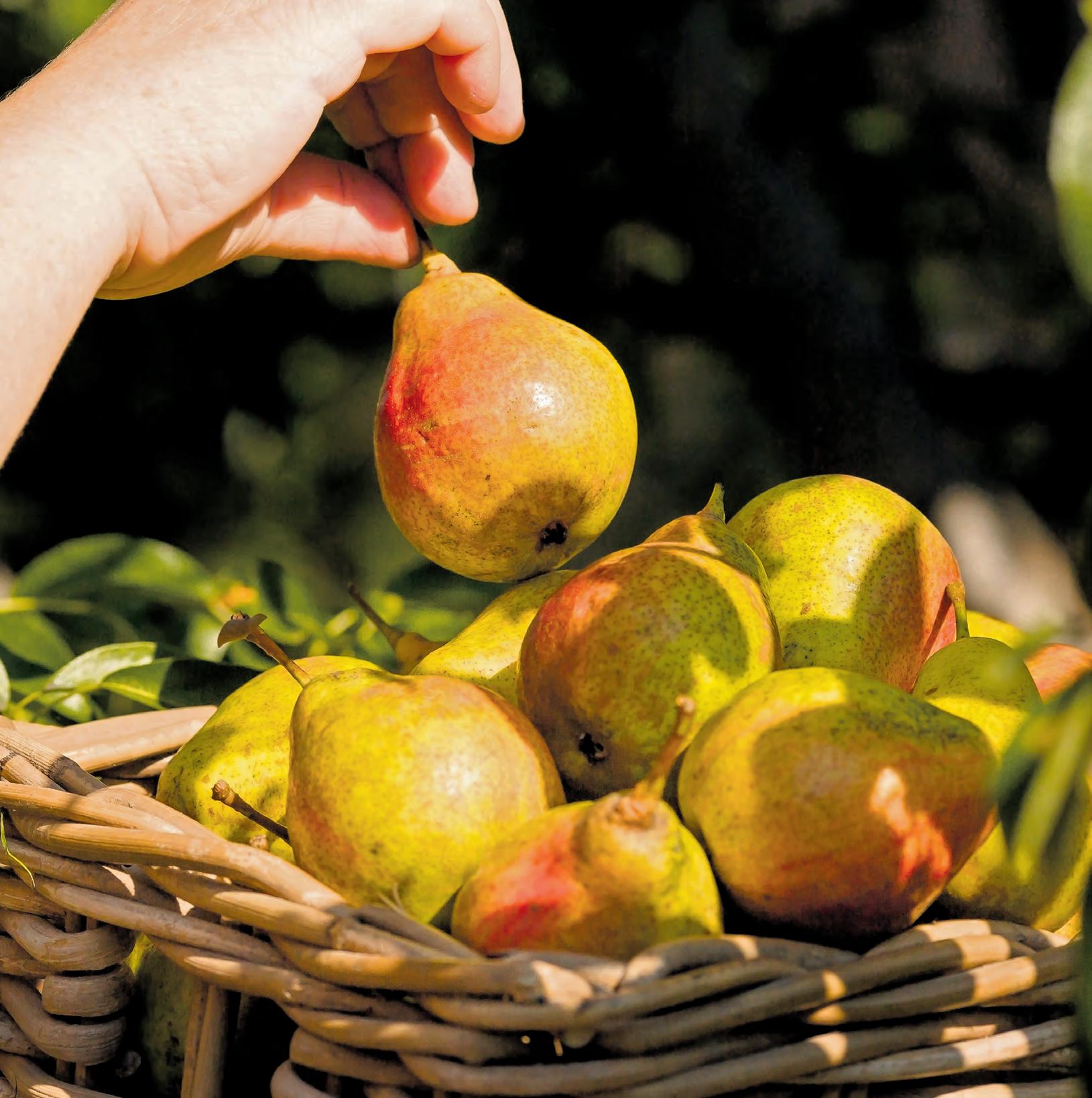



October golden days out The delights of scythingPLUS: Sorbus, the tree of life Become a better gardener The missing swallows of summer Garden news from around the Cotswolds Cotswolds www.countrygardener.co.uk Issue No 190 OCTOBER 2022 FREE The perfect pear TIMING IS THE KEY FOR ENJOYING THEM Autumn fruit growing special: Secrets of October tree planting; Great fruit for small gardens; The best tasting apples ever OPEN SIX DAYS A WEEK - Tues-Sat: 9am - 5pm Sun: 10.30am - 4.30pm ALSO OPEN BANK HOLIDAY MONDAYS M40 M40 STRATFORD UPON AVON LEAMINGTON SPA BANBURY SOUTHAM BICESTER DAVENTRY M40 J11 A422 A423 A425 A361 B4100 CHIPPING NORTON Farnborough Garden Centre AT THE GARDEN LOVERS GARDEN CENTRE On A423 Southam Road, Nr. Farnborough, Banbury OX17 1EL. Tel: 01295 690479 Autumn Gardening www.farnboroughgardencentre.co.uk A traditional garden centre that focusses on providing quality plants, garden products & giftware
Looking for a different shopping experience?
A unique independent family run business nestled in the heart of Ross on Wye, a small market town on the banks of the river Wye in an area of outstanding natural beauty.
Bursting with 100’s of seasonal plants all housed undercover, and with a shop full of unusual gifts you won’t see on the high street, this is a must see destination.

The main shop is found within an historical “Brunel” designed “Engine Shed” building-formerly of the Great Western Railway, and houses a wonderful café serving homemade cakes, light lunches and their signature “cheese scones”.

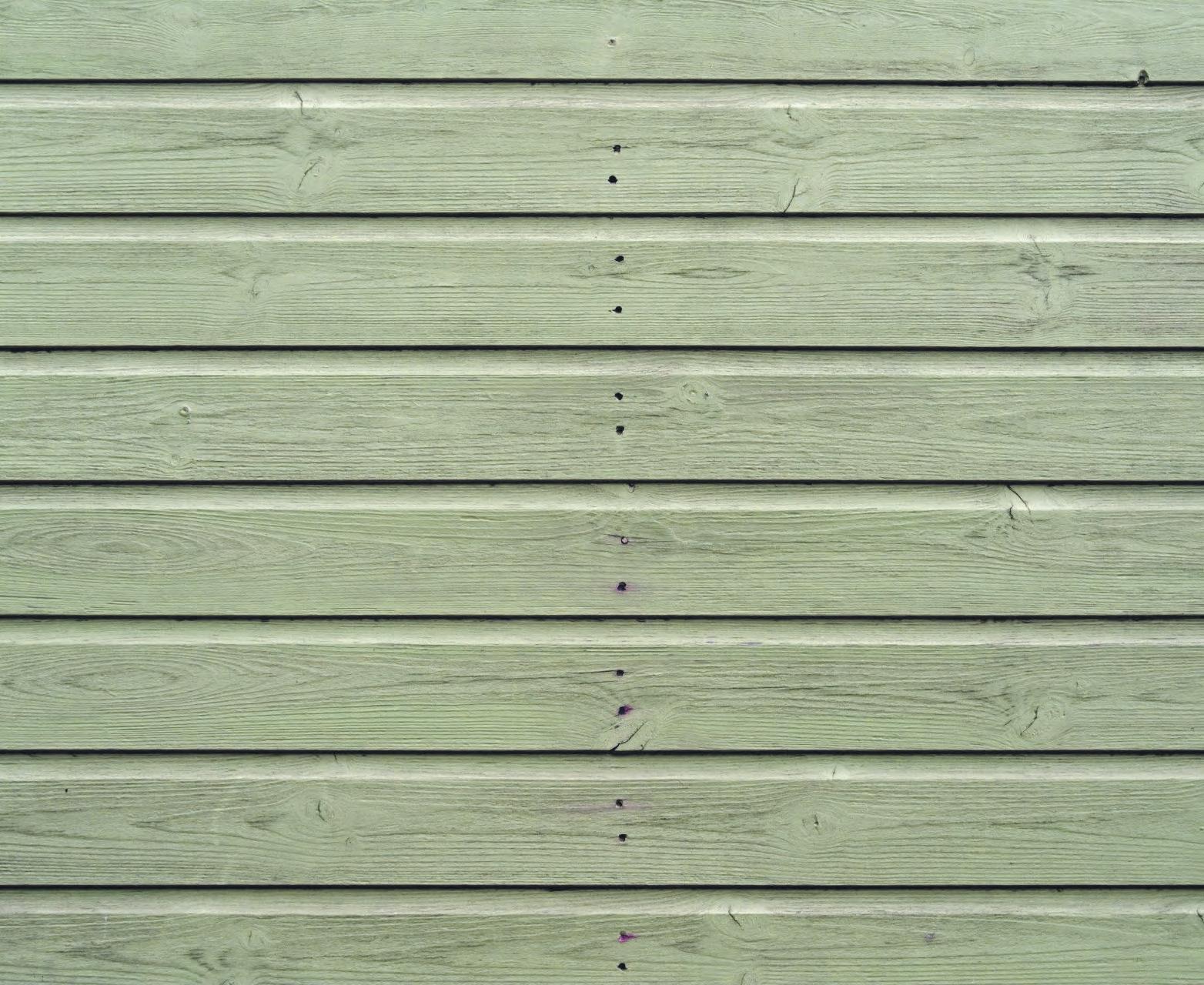
Great customer service, coupled with knowledgeable staff always willing to help.
Why wait - make it a date in the diary - you won’t be disappointed!
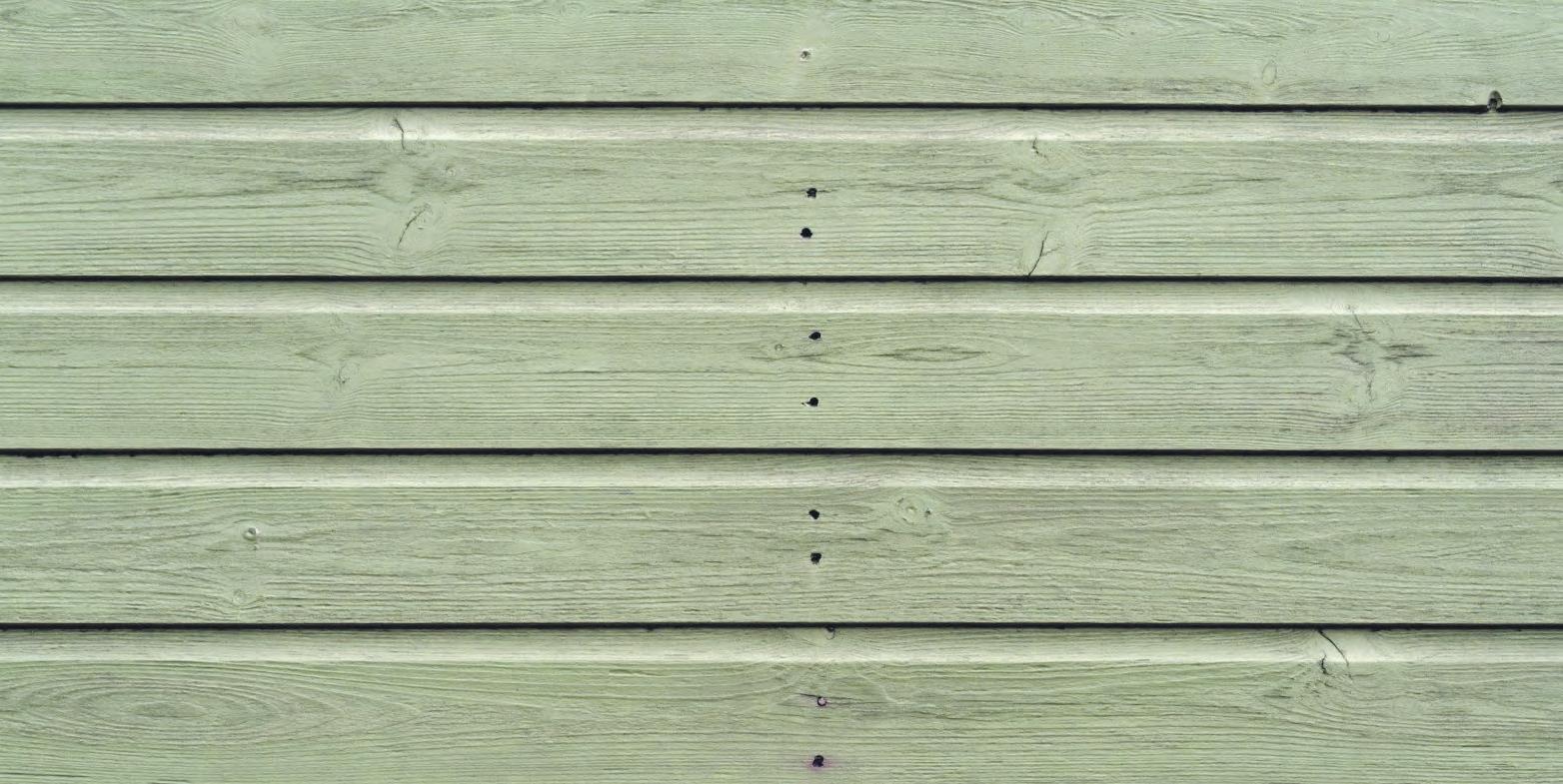
ROSS GARDEN STORE OPEN 7 DAYS PER WEEK 9am-5pm Mon-Sat 10am-4.30pm Sun Open Bank Holidays *café opening times differ
Look no further than Ross Garden Store!
The Engine Shed, Station Approach, Ross-on-Wye, Herefordshire HR9 7BW 01989 568999 www.rossgardenstore.com online@rossgardenstore.co.uk www.rossgardenstore.online
Gardeners cuttings in the Cotswolds
A LOOK AT NEWS, EVENTS AND HAPPENINGS IN YOUR AREA
Growing your own veg can save £690 a year
Rebecca Wilson’s garden design beliefs include dispelling the myth that to be good for nature, gardens must be overgrown and unruly.
The former ecologist who managed habitats for wildlife and helped to re-establish native species back into depleted landscapes, now has her own Cotswolds based gardening design business.
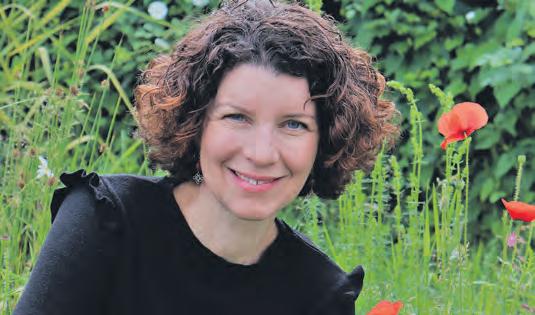
“WildSide brings together my knowledge of the natural world with my love of plants and gardening. Providing the backdrop to our lives and anchoring our homes in the landscape, gardens also provide a valuable refuge for species that often struggle to find habitat in the wider environment.
“My designs pull together the needs of people and wildlife and dispel the myth.”
After studying zoology and conservation biology at university she worked in conservation, surveying habitats and helping to restore species such as the large blue butterfly, pine marten and beavers back into the landscape.
“ Although my passion for the natural world has never waned, more of my time at work was spent sending emails from an office. I longed to get outside and do something creative and practical.

“My designs are based on strong geometry and architectural structure to tie the garden to the house and the environment beyond but softened and brought alive using plants chosen for their attractiveness to wildlife and their ability to thrive in the conditions available.
“Inspired by soft, loose planting and allowing plants such as verbena, foxgloves and fennel to self-seed and spread around the garden, plants are at the heart of my designs, providing layers of habitat for a range of wildlife as well as texture and colour throughout the year.” www.wild-side.org Email: rebecca@wild-side.org Tel: 01989 565380 & 07908011934 Covering Herefordshire, Gloucestershire and Monmouthshire. Outside these areas will be considered.
New research which was carried out interviewing allotment holders in Somerset and the Cotswolds has found that growing your own vegetables could save you as much as £690 from your shopping bill. Eating homegrown produce including fruits, vegetables, and herbs is not only beneficial for the environment, but also for your health and even your finances. In fact, Admiral Home Insurance revealed that households can save as much as £150 per year on their shopping simply by growing beetroots and peas at home. While it may take time and patience, the financial advantages of planting and harvesting your own fresh produce are unbeatable and could claw back as much as £690 per year from your shopping list.
The cost of growing common fruits and vegetables has skyrocketed this year as a result of inflation and the war in Ukraine.
According to the British Retail Consortium, food producers have been forced to pass on the increased cost of fertiliser, wheat, and vegetable oils - large amounts of which are produced in Ukraine and Russia, in order to continue farming and producing items.
While growing your own produce may seem like a long-winded solution to avoid rising costs, the financial returns are more than worth it if you’re working on a tight budget.
Most of these money-saving vegetables don’t take long to grow either, with several seasonal varieties guaranteed to start paying off in as little as two weeks after planting them.
Special Plants nursery and garden opening for the NGS in October
The garden and nursery at Cold Ashton near Bath that’s owned by top garden designer and gardening author Derry Watkins opens for the National Garden Scheme in October.

Special Plants at Greenway Lane, Cold Ashton SN14 8LA is an architect-designed three quarter acre hillside garden with stunning views, and masses to see: exotic plants, gravel gardens for borderline hardy plants, a black and white (actually purple and silver) garden, vegetable garden and orchard, hot border, lemon and lime bank, spring
BACKDOORSHOES READY FOR AUTUMN ACTION
Backdoorshoes have introduced more designs to their range of waterproof, lightweight garden clogs to include Bees, Green Camo and a Slate design.
Perfect footwear to slip on/off and nip outdoors to tend to the garden, walk the dog and even put out the bins! Prices start from £32.95 including free standard delivery. Sizes available from UK 3-14.
There are a range of flip flops featuring their unique prints to include Poppies, Meadow, Grass and Camo. However, as the weather is changing all the time there are a wide variety of Ultralight Wellies or Chelsea boots to choose from. Footwear for all weather.
Proud to be British designed. For the full range please visit www.backdoorshoes.co.uk or call 01202 232357
fed ponds, a bog garden and a woodland walk. The garden opens for the NGS on Thursday 20th October, from 11am until 5pm. Admission is £5, children free.
Homemade teas will be available, and plants for sale, mostly in the plant nursery. Dogs are allowed. There’s a free list of plants in the garden. For other opening times and information contact by phone on 01225 891686 or email derry@specialplants.net or visit the website at www.specialplants.net
Traditional pumpkin festival at Cotswolds Farm Park

Autumn has nearly arrived at the popular Cotswold Farm Park which means pumpkin season has arrived…so throw on your wellies and get ready for a day of autumnal activities!
Promising to be bigger, better, and plumper than ever, the Farm Park’s Pumpkin Festival is an October event not to be missed.
One for all the family, guests will delight at the ‘spooktacular’ activities, decorations, and selfie stations, before choosing those all-important carving pumpkins to carefully carry home.
The pumpkin field will be open on October weekends and throughout half term from Friday, 21st October to Monday, 31st October 11am to 5pm.
Cotswold Farm Park, Guiting Power, Cheltenham, Gloucestershire, GL54 5FL
Garden designer aims to dispel a few myths with design business
Rebecca Wilson: “My designs are based on strong geometry”
CUTTINGS
www.countrygardener.co.uk 3












Country Gardener4 Find out more about care near you: 0800 988 8133 • www.osjct.co.uk # HereToCare Here to ResidentialCareDementiaCare Nursin g Care Respite Care Day Care As a leading ‘not-for-profit’ provider of care for older people, The Orders of St John Care Trust can help you make the right choice for care in later life. • A home with compassion, warmth and understanding • Working closely with Dementia UK - one of the few care providers to employ Admiral Nurses, specialists in dementia care • A professional, friendly, caring ethos
Colourful autumn gardens opening for the NGS in Herefordshire in October

Autumn colour is in abundance in three Herefordshire gardens opening for visitors to enjoy for the National Garden Scheme in October.
Ralph Court Gardens, Edwyn Ralph, Bromyard, Hereford, Herefordshire HR7 4LU opens for the NGS on Saturday 8th and Sunday 9th October, from 10am until 5pm each day. There are 12 amazing gardens set in the grounds of a gothic rectory overlooking the Malvern Hills, a family orientated garden with a twist, incorporating an Italian Piazza, an African Jungle, Dragon Pool, Alice in Wonderland and the elves in their conifer forest and a new section, ‘The Monet Garden’. Admission is £10 adults, £7 for children; a 120 seater licenced restaurant offers daily specials and Sunday roasts. Wheelchair friendly. Plants for sale. Coaches welcome.
Lower Brook, Bridstow, Ross-On-Wye, Herefordshire HR9 6QF opens for the NGS on Sunday 9th and Monday 10th October, 11am-4pm each day. A sloping, two-acre landscaped garden with a mixture of hard landscaping, a waterfall, lawns, flower beds and a blaze of autumn colour with 124 trees (some exotic species) and a similar number of shrubs. Some parts of the garden are only accessible by steps. Admission £5, children free, pre-booking essential. Homemade teas available, dogs allowed.
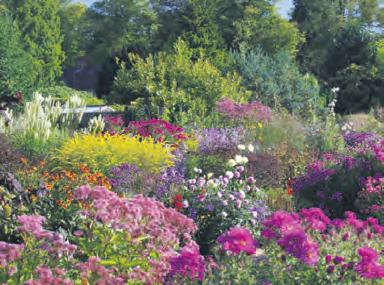
The Picton Garden, Walwyn Road, Colwall, Herefordshire WR13 6QE opens for the NGS on Thursday 20th October from 11am until 5pm, a plantsman’s garden of 1½ acres west of the Malvern Hills. In late September and early October colourful borders display the National Plant Collection of Michaelmas daisies, backed by autumn colour in the trees and shrubs. There are many unusual plants, including more than 100 different ferns and acers, raised beds and a silver garden. There’s an extensive nursery that has been growing the asters since 1906. Admission £4, children free. There are gravel paths but all are fairly level, with no steps. Plants for sale, coaches welcome.
www.ngs org.uk
...and Hill Close Gardens have late October opening date
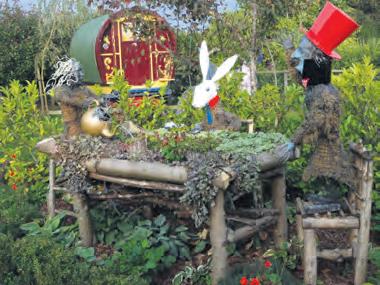
Hill Close Gardens, Warwick, Warwickshire
CV34 6HF open for the National Garden Scheme on Saturday, 29th October from 11am until 5pm. The restored Grade ll* Victorian leisure gardens comprise 16 individual hedged gardens, eight brick summerhouses, herbaceous borders, heritage apple and pear trees, many varieties of asters and chrysanthemums, heritage vegetables, a plant heritage border, auricula theatre, Victorian style glasshouse and children’s garden. Admission £5, children £1, dogs allowed, plants for sale, coaches welcome and a wheelchair is available – please phone to book in advance. Before you visit, check the website for up-to-date information.
Hill Close Gardens Trust, Tel. 01926 493339 www.hillclosegardens.com
Gardening club events and meetings in the Cotswolds
October
1ST
Cottage Garden Society
‘THEY THINK IT’S ALL OVER BUT IT’S NOT YET’ - PAUL GREEN Details on 01564 783475
5TH
Bishampton and District Gardening Club
‘PONDS AND THE IMPORTANCE OF WATER IN OUR GARDEN’ - JO WORTHY-JONES Details on 01386 462436
6TH
Churchdown Horticultural Society
‘TRUG MAKING FOR A MISERABLE OLD TRUGGER’ - CARL SADLER down.secretary@gmail.com
10TH
Southam Gardening Club
‘GARDENS IN THE TIME OF JANE AUSTEN’ - MICHAEL BROWN Details on 01926 813986
13TH
Alderton Gardening Club
‘DIG FOR VICTORY’ - FIONA WARIN www.aldertonvillage.co.uk/aldertongardening-club
Cheltenham Horticultural Society
‘GROWING NATIVE ORCHIDS INTO YOUR GARDEN’
- WILSON WALL
Details on 01242 691135
17TH
Abbeydale Garden Club
‘NEW PLANTS FROM OLD’ - DAVE CROPP Details on 01452 540790
Warwickshire Group of the Alpine Garden Society
‘AFRICAN EXTREMITIES’
- DAVID CHARLTON Details on 0121 7443129
18TH
Lawn Gardening Club
‘A HISTORICAL INTRODUCTION TO THE GARDENS’
- MARGIE HOFFNUNG Details on 01793 523099
19TH
Chipping Norton Horticultural Association
‘BORDERING ON INSANITYCREATING AN ALL-YEAR-ROUND BORDER’ - TIM WALKER
Details on 01608 643275
Codford & District Gardening Club ‘THE WONDERS OF WESTONBIRT’ Details on 01985 850258
20TH
Newest Gardening Club
‘GARDEN PHOTOGRAPHY’
- ROBERT BRYANT
‘Time Off’ set to return
If your gardening club or association is back in full swing after the restrictions of the past couple of years be sure to let Country Gardener know. Send your club meetings and details to timeoff@countrygardner.co.uk
Celebrating garden owners’ ten years of fundraising
Apple Day Play at Snowshill Manor
Shakespeare Morris will perform their ‘Apple Day Play’ - a mummers’ play following the story of England’s ancient orchards and their heritage varieties at Snowshill Manor on Saturday 22nd October.
The play is written in the tradition of ancient mummers’ plays which have a history dating back to at least the 13th century and have been well-documented in the Snowshill area from the 1850s onwards. Snowshill has its own mummers’ play as did nearby Broadway, Blockley and Weston-sub-Edge to name but a few, all of which are now performed by Shakespeare Morris. From 2pm onwards.
Snowshill Manor and Garden (National Trust), Gloucester, Broadway, Gloucestershire GL1 1GH
This year saw five Gloucestershire gardens celebrate their tenth anniversary of opening for the National Garden Scheme and the owners duly received their long service awards. Awards were presented to Susan and Richard Wakeford at Charingworth Court, Winchcombe, Nicholas and Mel Tanner at The Coach House, Ampney Crucis, David and Henrietta Howard at Daglingworth House, Daglingworth, Rupert and Mandy Williams-Ellis at at Snugborough Mill, Blockley who open as part of the Blockley Gardens group, and Bryan and Christine Bamber at The Gables, Broadoak, who are retiring from the scheme.
Bryan Bamber said: “After ten years of a really enjoyable experience opening for the National Garden Scheme, we need a rest and to make changes which will take some time.”
Gloucestershire NGS have thanked them for their generosity and wish them well. There are still a couple of Gloucestershire gardens opening by arrangement for the NGS in October: Brockworth Court, Brockworth, for groups of five to 30 people, and Radnors, Lydbrook for groups up to ten people. The owners should be contacted directly, details on the NGS website, in the annual handbook and in the county booklets.
Now all the NGS county teams and the national headquarters are preparing to launch next year’s programme, with around 3,500 garden owners across the country registering their opening dates and details for 2023, which will appear in the annual Garden Visitor’s Handbook, the county booklets and on the NGS website at www.ngs.org.uk
Friday, 28th October
www.countrygardener.co.uk
Ralph Court Gardens
Lower Brook
The Picton Garden
CUTTINGS
Look out for the November issue of Country Gardener on
5
PLANNING FOR THE AUTUMN
NICHOLSONS LOCKHART GARRATT’S HORTICULTURAL EXPERTS COMBINE TO HELP YOU PREPARE FOR AUTUMN. READ ON FOR GARDEN INSPIRATION…
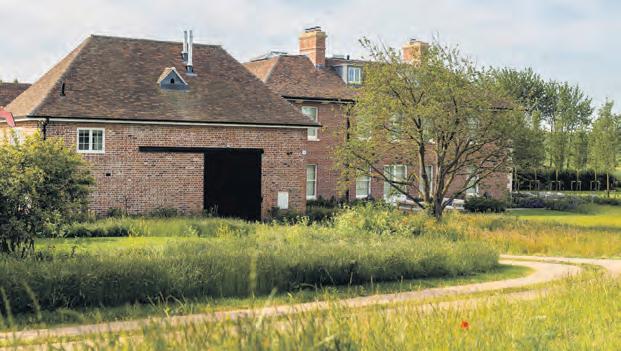

After spending one of the hottest summers on record gazing out over parched lawns, drooping flowerbeds and cracked ground, we’ve been given a stark reminder of the dramatic effects that adverse environmental conditions can have on the landscape around us.
As the land finally starts to cool and rain makes a welcome comeback, autumn is the perfect time to start planning, preparing and planting so that no time is wasted in introducing your choice of new plants to the correct growing conditions.
Understanding the unique conditions of your site as well as the qualities and attributes of certain plants will enable you to make informed decisions, rather than buying on impulse. A plant well suited to its site will be happy and healthy and, as a result, will be less labour intensive. A plant struggling for survival will require more maintenance and may attract more pest and disease problems, with consequent pest management cost. Additionally, precious resources such as water, can be conserved thus increasing the sustainability of your plot.
There are several factors which affect growing conditions and the plant choices you make which all combine into a single mantra; the right plant in the right place.
FINDING THE RIGHT PLACE
Soil texture, structure and pH
Soil is one of the most important factors for consideration when planting and growing. It is the foundation of all terrestrial life and the condition and quality of your soil will have one of the strongest influences on the success of your planting.
Texture refers to the distribution and dominance of three major particle types; sand, silt and clay and is the most permanent and unchangeable feature of soils.
Structure is the way in which these main particles are arranged and how they interact with the other

soil particles such as organic matter, air and water. The structure determines most of the physical, chemical and biological components of the soil and can be easily altered through good or poor management.
pH of soils is important as it affects the solubility of elements and compounds and therefore what nutrients may be available or limited within your soils.
Although soils can be worked at any time of year, autumn is the ideal time for making changes as there is a reduced risk of freezing, drought or waterlogging which can occur more frequently in winter, summer or spring.
Topography and Microclimates
Understanding how the contours and unique properties of your plot will affect your planting is often overlooked but can strongly influence the success or failure of your scheme.
Topography can mean entire areas or just particular spots of a garden may hold or loose water more than others. For example, a sloping garden may be dry at the top of the slope but damp at the bottom, even if the soil type is constant throughout. Additionally, nutrients tend to be carried with the direction of the water and therefore may vary across a sloping site.
Microclimates can occur in gardens of any size. These can include such things as hot spots against a wall or fence, wind protected areas behind hedges or buildings and cooler, shaded areas under a tree. This can give you the opportunity to choose different plants for certain areas that would otherwise not be suitable in others within the same garden.
Water, wind and light
A variety of environmental conditions play a significant role in the success or failure of plant health and growth.
Water is a fundamental necessity for healthy plant growth, and each plant requires different amounts
of water depending on the species, the soil and the environmental conditions. Sustainable water management requires appropriate watering use, especially during plant establishment, whilst preventing water loss through the integration of organic matter and mulching the surface.
Wind removes moist air surrounding the plant and replaces it with by cooler, drier air thus increasing the plants transpiration rate. The type of plant, temperature and humidity also affect the rate of transpiration, but Autumn can bring windier weather whilst still being warm, so it is important to remember water loss through this process is still a risk at this time of year.
Wind can cause broken or damaged branches which need to be pruned back to prevent diseases taking hold through wounds, which would weaken the plant and attract pests. Additionally, wind movement can loosen the soil around roots making them more susceptible to drying out. This is especially important for new planting and shallow rooted plants (such as fruit trees and roses).
Light intensity, quality and duration contribute to the growth of plants by affecting the rate of photosynthesis. Intensity is the amount of light photons the chlorophyll absorbs, with every plant requiring a different minimum and maximum amounts. Quality is the range of wavelengths required for optimal photosynthesis and the duration of light the plant receives affects photosynthesis and reproductive growth, which means flowering times for different plant are triggered not only by the length daylight but also the length of darkness.
Country Gardener6
FINDING THE RIGHT PLANT
Choosing the right plant can seem daunting at first, but if you already understand your site, using our guideline above, you are one step closer to choosing your perfect plant. Knowing what you want the plant to provide is a necessary step, so considering the following purposes can help guide your decision:
• To provide shade or privacy
• To provide instant impact
• Be low maintenance
• Be child/animal friendly
• To provide colour, texture or a focal point
• To provide year-round greenery
• To provide height or ground cover
• To produce food (fruits, nuts etc.)
Combining the intended use with different site requirements can offer a wide choice of planting options to give your garden the best possible impact and long-term success. Mistakes can be made when a plant’s characteristics have not been taken into consideration, such as height, width, spacing, speed of growth, water requirements or growing tolerances. Although a plant growing in the wrong place can be moved, this creates extra work and waste if the plant does not survive and must be replaced.
TREES
Cotoneaster frigidus ‘Cornubia’ is a semi-evergreen, multipurpose plant which can be grown as a tree or shrub. It is very tough and thrives on in most conditions including dry soils, partial shade or full sun, with the exception of damp sites. Additionally, the flowers are highly attractive to pollinators.
Alnus glutinosa is a native tree which can withstand most sites, including damp soils, exposed sites in partial shade or full sun. It produces lush green, oval leaves and catkins for winter interest.
Cercis siliquastrum is well suited to hot, dry sites and is usually multi-stem in habit, providing a spreading, dappled canopy of heart-shaped leaves with beautiful purple flowers in spring and copper tones in autumn.
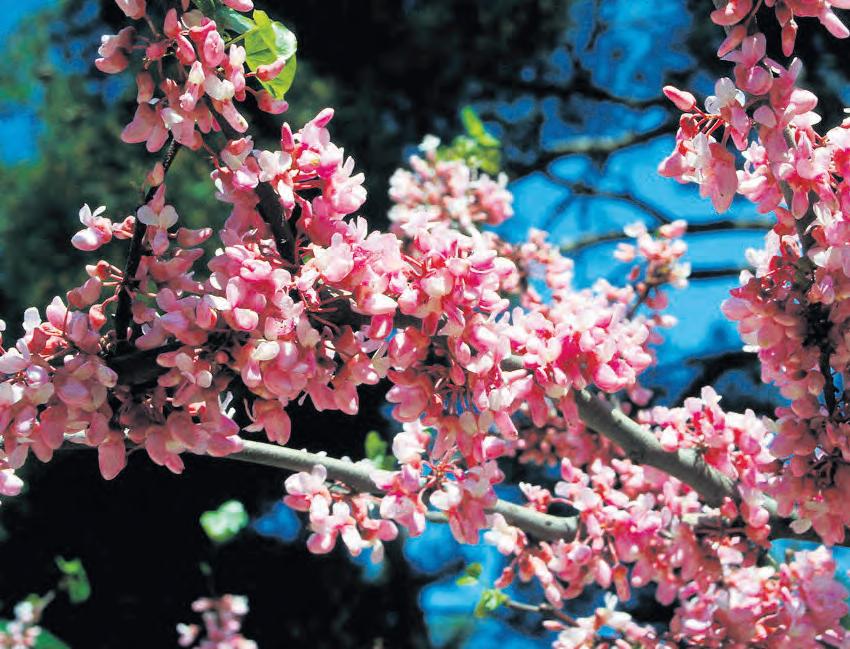
Ginkgo biloba - is a slow growing tree well suited to hot, dry sites and is highly pollution tolerant. Also known as the ‘fossil tree’ as it is the last living species of its order, its distinctive leaves turn striking yellow in autumn.
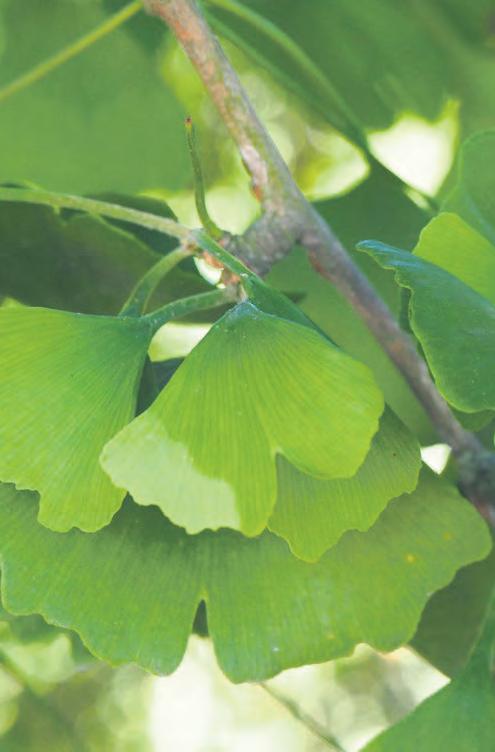
SHRUBS
Hydrangea ‘Limelight’ is a robust shrub which thrives in damp, partial shade. Its large, light green leaves and sizable white, conical flowers makes this plant light up any dreary corner.

Viburnum tinus is an excellent ‘all-rounder’, thriving on most sites and can be easily pruned to fit most spaces. With dark, evergreen leaves, this shrub flowers most of the winter months, bringing an uplifting display of delicate, pink-tinged colour. Sambucus nigra ‘Black Lace’ is suitable to grow in exposed sites despite its delicate appearance. Dark purple, deeply dissected leaves are punctuated by umbels of pink flowers in summer, bring contrasting interest amongst the greenery. Osmanthus burkwoodii is ideal for a dry, shady spot in the garden. Its glossy evergreen leaves and highly scented white flowers in spring make this plant a must have for any garden.
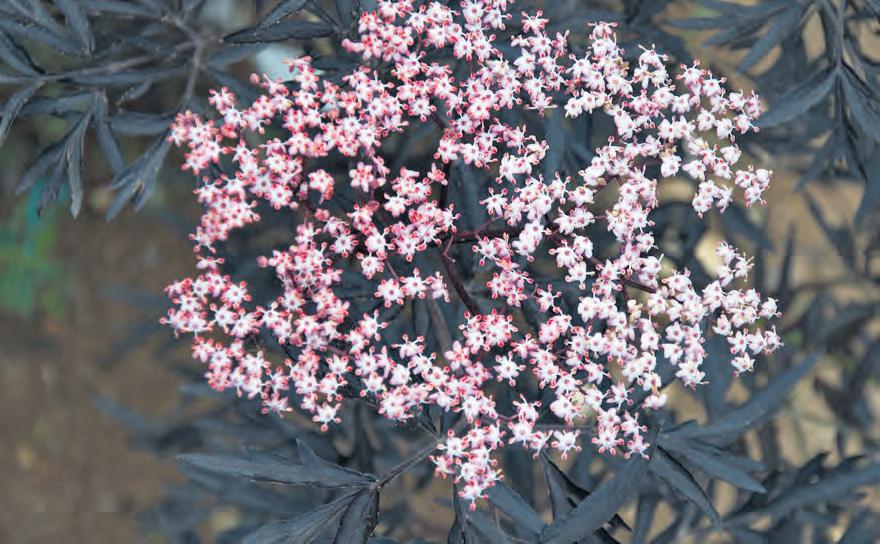
HERBACEOUS
Geraniums are another fantastic all-round plant. With so many varieties to choose from in a whole host of foliage and flower colours, including ‘Rozanne’ for clay soils or phaeum for dry, shady sites, there will always be a spot in your garden for one of these great herbaceous fillers.
Ferns are typically associated with damp, shady places and bring a luscious tropical feel, but some of these family members can also be grown in dry shade too, such as Asplenium scolopendrium (the ‘Hart’s-tongue’ fern).
Aster novi-belgii is well suited for clay soils and all Asters offer a splash of late summer and autumn colour when many other flowers are finishing.
Stipa gigantea is a lovely, soft grass which is suitable for most soils including sandy soils. The gently flowing leaves move like water in a breeze, offering a great textural feature to any border.
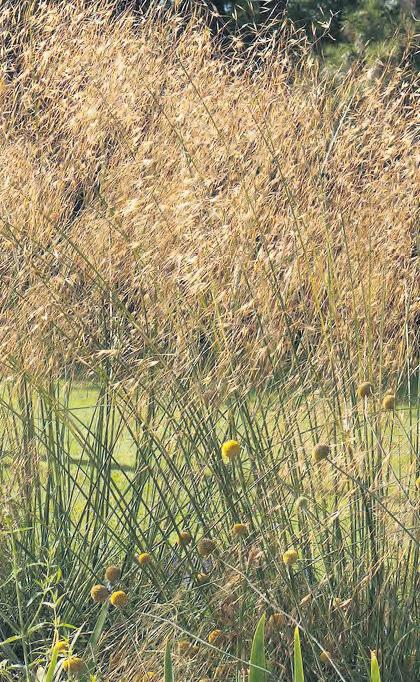
If you are considering a new design for your garden, why not contact the Nicholsons Lockhart Garratt design studio? You can email us at gardendesign@nicholsonsgb.com or call the team on 01869 340342 (option 2).
If you would like to discuss our wide range of plants, please contact the plants’ sales team at plantsales@nicholsonsgb.com, or call us at 01869 340342 (option 1).
Cercis siliquastrum
Stipa gigantea Hydrangea ‘Limelight’
Ginkgo biloba
Sambucus nigra ‘Black Lace’
7
Pygmy Pinetum NURSERY & GARDENS
Come and enjoy our lovely garden while shopping in safety, taking your pick from the glorious selection of plants we have to offer.
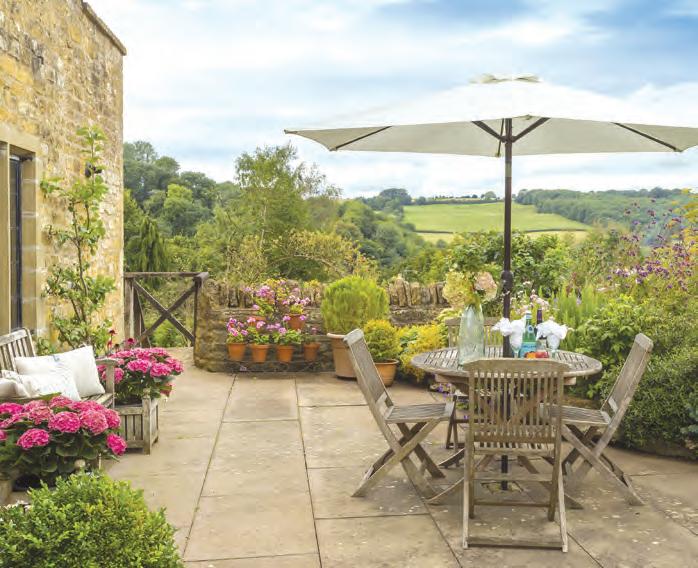
Trees - Ornamental and Fruit
Excellent quality and a wide range. Something glorious for all types of garden.

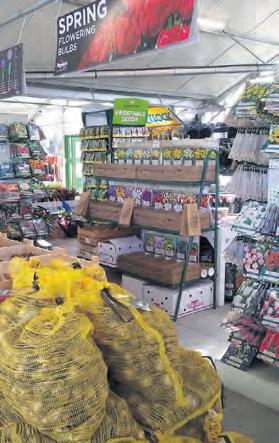



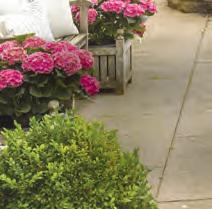

Spring flowering bulbs
Favourites and more unusual varieties to plant now for a stunning spring display.
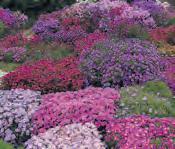

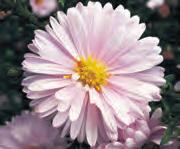
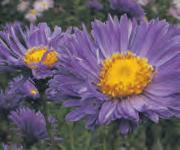

Autumn and Winter colour Pansies, violas, heathers and more to fill your containers with the splendour of spring, or you can let us plant them for you.
Shrubs and Perennials
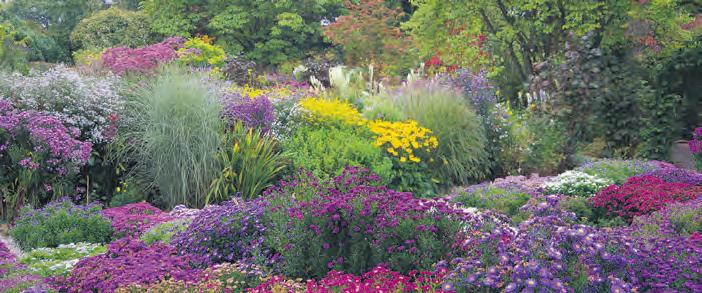
Lots now available and a perfect time for planting. A wide range of evergreens for a bright display all year round.

Cannop Crossroads, Nr Speech House, Royal Forest of Dean, Glos. Tel: 01594 833398















www.pygmypinetum.co.uk







Country Gardener8 ■ Competitive commission rates ■ No joining or annual fee ■ A Marketing Marketing and Managed ■ Professional photography ■ No restrictions on use of your property ■ Peace-of-mind damage cover Open your doors to staycations At Cotswolds Hideaways our local team is well placed to help you let your holiday home. We’re always looking to expand our portfolio, so why not get in touch today and ask for your FREE Property Letting Guide? Service 01451 888 040 cotswoldshideaways.co.uk Gretton Road, Gotherington, Cheltenham GL52 9QY 01242 676722 www.gotheringtonnurseries.co.uk info@gotheringtonnurseries.co.uk 1 mile from Prescott Hill Climb. Open Mon-Sat: 9am-5pm Sun: 10am-4pm GREAT RANGE OF BULBS FOR AUTUMN PLANTING Autumn bedding plants, hanging baskets & planted containers Fruit & ornamental trees, shrubs, hedging & soft fruit plants Plant, lawn & garden care products Specialist composts & decorative gravels Barrels, terracotta & glazed pots Specialist bird care products
Tel: 01684 540416 www.autumnasters.co.uk Old Court Nurseries, Walwyn Road, Colwall WR13 6QE The Michaelmas Daisy Specialists since 1906 Open daily, 11am to 5pm until 20th October. Garden admission £4 for adults. Season Tickets available offering 12 months of garden entry and 10% discount on purchases over £20. Open THURSDAY 20TH OCTOBER for the National Garden Scheme OPENING TIMES FOR THE YEAR: 1st Feb - 31st July, Wednesday to Saturday / Throughout August, Wednesday to Sunday (plus BH Mon) / 1st September - 20th October, Daily. Open 11am - 5pm (except during Feb/Mar, 11am-4pm) Old Court Nurseries & The Picton Garden Specialist nursery and beautiful 1.5 acre garden just waiting to be explored CATALOGUE ONLINE OR AVAILABLE BY REQUEST
One swallow may make a summer
Diana Redfern is concerned that the number of swallows sharing our summers with us is on the decline
It seems so sad that the number of swallows that migrate to us in summer is declining so drastically.
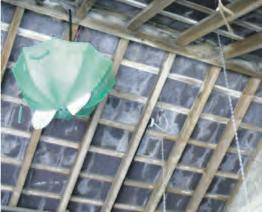
Flies of all kinds, beetles, moths and aphids are just a few of the enormous variety of flying insects that a swallow is catching as it skims, turns and dives with breathtaking agility over pastures, hedges and mature trees.
All the better if there are sheep, cattle or horses grazing. They attract even more insects.
An
1,000 visits needed over 21 days
The swallow whilst in flight, can somehow tightly pack a mixture of insects held together with saliva. Such a bolus would typically include 11 large and up to 40 smaller items which are fed to the young. A pair of swallows is likely to make between ten and 25 visits to the nest every 30 minutes, depending on the time of day, availability of insects and needs of the young. Bringing up three youngsters from hatching to fledging needs approximately 1,000 visits to the nest over 21 days.
Exhausting work.
An awful lot of insects are needed. However evidence shows without question that insect numbers are decliningperhaps because of the intensification of farming with more monocultures and fewer ponds, orchards and meadows plus the routine use of pesticides. New housing takes up former farmland. Each leads inevitably to the loss of habitats and food sources for many, including the swallow family.
Swallows seem doubly threatened. Their traditional association with humans means that swallows have a particular liking for buildings – barns, porches and stables in which there are ledges or solid rafters on which they can secure their nests. These are made of individual pellets of mud cemented together with grasses into a beautifully symmetrical cup shape. Such a nest takes about ten days to construct and another day to line with feathers. Once built it is likely to remain as a permanent home for future generations of that family, unless, of course, it is removed. It is astonishing that nests are destroyed because of the mess created over the breeding season.
The modern trend for barn conversions means eviction for many swallows. How shocking that after a huge migratory journey (6,000 miles approximately) back home, the swallow finds no home. Added to this is our penchant for tidiness, and security, meaning that once open garages, roof spaces lofts and barns are now sealed against all intruders including swallows, swifts and bats.
Throughout the UK swallow nests are legally protected if they have eggs or young but nests not being used are not. However, swallows always return to the same nest so this does not help the swallow.The state of the insect is equally hard to address without changes in the type of grasses sown and with the return of more sheep and cattle grazing out of doors. The increase of horse keeping and provision of stables seems a positive step for the entire swallow family.
Gardeners can play a huge part too. Creating a variety of habitats will encourage biodiversity including an increase in insect species, whilst cutting a swallow-sized hole in a shed/garage door will give access to a bird but not to an intruder (not even a cat or squirrel).
Swallows are birds evocative of summer days. It would be terrible to take them so much for granted that we miss the stresses from which they may well already be suffering.
My turn!
Friends of mine love their swallows so much that they hang umbrellas beneath each nest to catch baby birds that fall out and then they can be returned to the nest!
Let’s look forward to the return of more swallows in years to come and perhaps we can do our bit by encouraging insects and providing and keeping traditional nest sites.
...and why perhaps they are arriving late
There are two reasons for the lateness of the swallows in recent years. Unlike many other migrants, which fatten themselves up before they depart, these species feed as they travel, replenishing lost energy by catching flying insects. For that reason, they are especially vulnerable to bad weather en route. And the weather in southern Europe this spring – notably in southern Spain, which these birds cross after leaving Africa –was very unsettled, with heavy rainfall, strong winds and even falls of snow across parts of Andalucía.
The second reason is that in Britain, although the weather has been mainly dry, there have been persistent easterly and north-easterly winds, which slow down the birds’ progress as they head north.
How might this affect these global travellers in the longer term? Songbird migrants usually live for only one or two years, so they need to get down to raising a family as soon as they return. This means that delays of even a week or two can lower their chances of breeding successfully.
Swallows, which usually start nesting in early April, may only be able to raise a single brood rather than two (or even three).
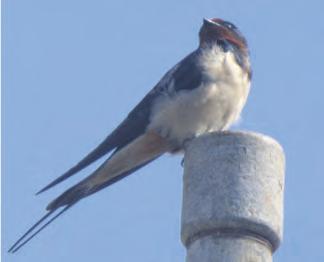
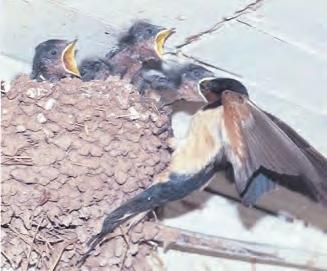
Since Aristotle noted that ‘one swallow does not a summer make’ – a sentiment echoed by Shakespeare and many others – millions have celebrated their annual return as the true sign of spring. There is an increasing fear the numbers may continue to decline.

WILDLIFE
umbrella net catches droppings
to feed youngsters www.countrygardener.co.uk 9
It’s time to plant
YOU CAN PLANT PRETTY MUCH ANYTHING IN THE AUTUMN. IT’S THE BEST TIME OF YEAR FOR PLANTING AS THE SOIL IS WARM AND WET
If you are never certain about the best time to plant trees there’s a clear answer.
It’s right now, in the often-beautiful days of autumn when there’s a distinct nip in the air.
Plants are dormant, and weather and soil conditions are at their best to give your trees or shrubs the time they need to establish without stressing out.
There are some obvious (and some less obvious) reasons for this. The autumn sees lower temperatures which means there is less loss of water from foliage and so less call from water from the roots. Falling temperatures mean that the enzymes that drive biochemical reactions slow right down. The combination of this with shorter days mean that trees refocus their energy into their roots rather than their leaves. Since you want your trees to establish from their roots up, all this works in your favour and makes autumn a great time to plant or indeed to move or transplant.
Secondly, there is still some warmth in the soil. Tree roots continue to grow a little during dormancy and especially so when the soil retains a little warmth, as in autumn. The consequent root growth means that in spring a tree’s progress is more advanced because it is better placed to take up water and nutrients.
Thirdly, autumn is often wet, with less need for watering once you have planted.
This all applies to pot grown, rootballed and evergreen trees which should ideally be planted in October and into November. It makes less of a difference to deciduous trees but they do also benefit from early planting although for them that means November as a general rule. It is important to wait until the tree has drawn down all of the nutrients it can from its leaves. It is the transfer of nutrient to the root that is important here, not the shedding of leaves. Some trees, such as beech for example, hold their leaves for months after they have dried and become (nutritionally) useless.
Bare root trees ready for your garden at Perrie Hale Nursery
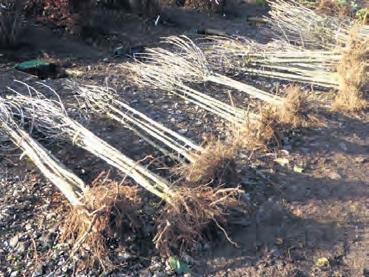
Autumn and winter are the optimal months for planting trees and hedges. Many species of trees can be planted bare-root, most of
COIR SOLVES SO MANY PEAT FREE PLANTING PROBLEMS
CoirProducts.co.uk of Salike Limited offers an exciting range of products for gardeners and growers that are natural, biodegradable, and peat-free. They are ethically produced and sourced, with minimal harm on the environment.
Coir products are ideal for planting a variety bulbs and perennials. CoirProducts coir potting mix is easy to use and comes in a variety of sizes of blocks, bricks, and discs.
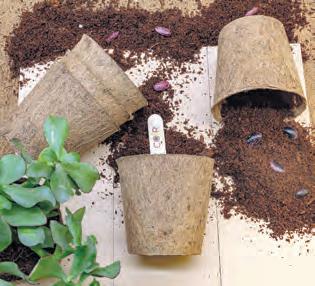
If growing perennials in containers, CoirProducts coir pots are a perfect alternative to plastics. Roots can grow through the coir pot as plants grow bigger and the pots can be easily repositioned with no transplanting shock when repotting. CoirProducts mulch mats help block sunlight and stop unwanted weeds from growing and destroying your plants, while CoirProducts grow poles are a useful support for plants that grow vertically. Coir also retains water and moisture well, benefitting plant growth.
Visit their website www.coirproducts.co.uk for further details or shop online.
BARTHELEMY & CO - THE JAPANESE MAPLES SPECIALISTS
Barthelemy & Co near Wimborne in Dorset was established by a French nurseryman almost a century ago and the Skinner family now specialise in propagating and growing Acer palmatum – or Japanese maples as they’re known.
the natives such as hawthorn, dog rose, field maple, oak, poplars and willow and some more ornamental varieties such as flowering cherries, rowan and crab apple.
Throughout spring, summer and autumn the delicate foliage of the acer presents exquisite shadings of Mother Nature’s gold, pink, purple, green, yellow, orange and red. Acers are a delightful addition to anyone’s garden, giving an aura of peace and tranquillity. The ten acre nursery at Stapehill has a huge collection of Japanese maples to choose from and expert staff are on hand to help select the right variety and to offer advice about caring for the trees in future. Over 100,000 acers are produced at Barthelemy and Co every year approximately 15,000 - 20,000 of them are grafted named palmatum varieties, as one of the largest specialist growers of their kind.
Pot grown ornamental trees will do best planted in autumn along with pot grown fruit trees. Bareroot fruit trees can be planted from December/ January. Perrie Hale have a wide range of apples, pears, plums and apricots and more unusual varieties such as quince and medlar.
Perrie Hale Nursery is primarily a wholesale nursery which also sells to the public. The nursery welcomes visitors but bear in mind it is a working nursery and there may be tractors moving about and you might need to bring your wellies!
You can download a catalogue or look at what is available on their website www.perriehale.co.uk or email faye@perriehale.co.uk
Empathy can kick start your spring bulbs with healthy root growth
To get your spring bulbs off to the best start possible use Empathy Bulb Starter at planting time. Bulb starter contains vermiculite to improve drainage and reduce the risk of your bulbs rotting off. Use Rootgrow mycorrhizal fungi to colonise your bulbs and add a secondary fungal root system, and seaweed meal which helps to increase root growth and enhances the growth of the mycorrhizal fungi. Bulbs are particularly dependent on mycorrhizal fungi which is why snowdrops establish better ‘in the Green’ rather than as dried bulbs as they have these beneficial fungi on the roots.
www.rootgrow.co.uk

Barthelemy & Co, 262 Wimborne Road West, Wimborne, Dorset BH21 2DZ Tel: 01202 874283 www.barthelemymaples.co.uk
LET ADAM’S APPLES SOLVE YOUR FRUIT TREE NEEDS
Now is the time to think about ordering your bare root fruit trees.
Adam’s Apples nursery in East Devon grows the largest range of fruit trees in the west country.
This includes over 200 apple varieties, plums, gage, pears, cherries, damson, quince and medlar, all on a range of root stocks. They also sell bare rooted soft fruit plants.
Adam’s Apples are passionate and award-winning cider makers too, and grow and sell some of the best traditional cider apple trees from Devon, Cornwall, Somerset and Herefordshire.
All the trees and bushes are sold bare rooted, available from late autumn through to spring.
Bare rooted trees are cheaper to purchase and easier to transport than potted trees and are the quickest way for trees to establish and thrive.
They are always happy to offer advice and recommendations for your garden, small holding, farm or community orchard and can deliver trees throughout the UK
Adam’s Apples Nursery, Dulford, Cullompton EX15 2GA
Tel: 07521 648502 sales@adamsappletrees.co.uk www.adamsappletrees.co.uk
Bare root trees ready to plant in early autumn
PLANNING & PLANTING
Country Gardener10

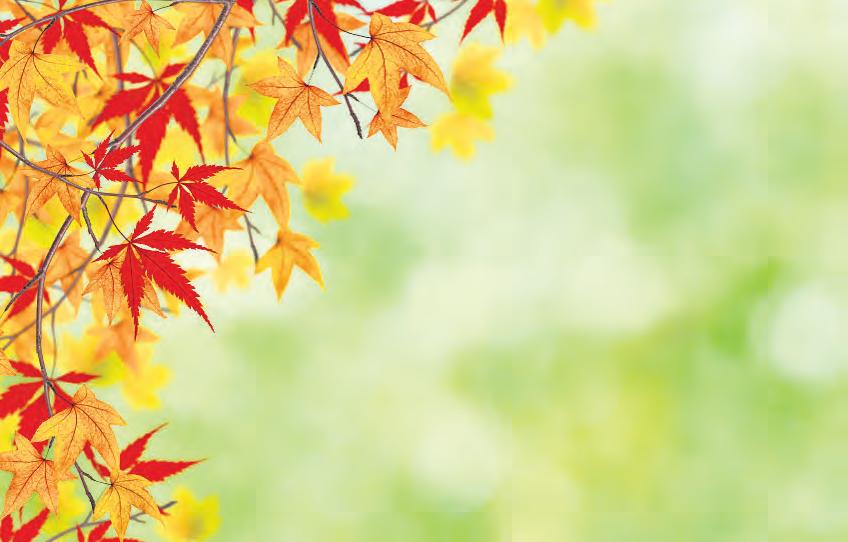


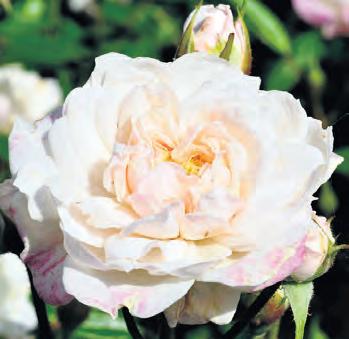

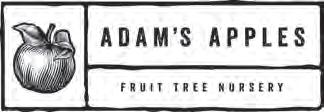
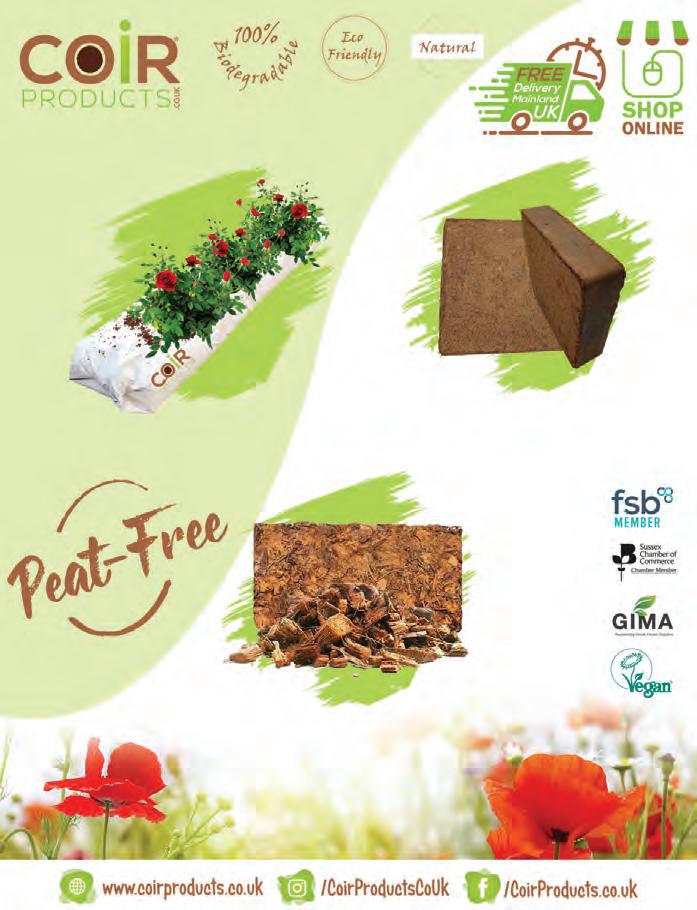

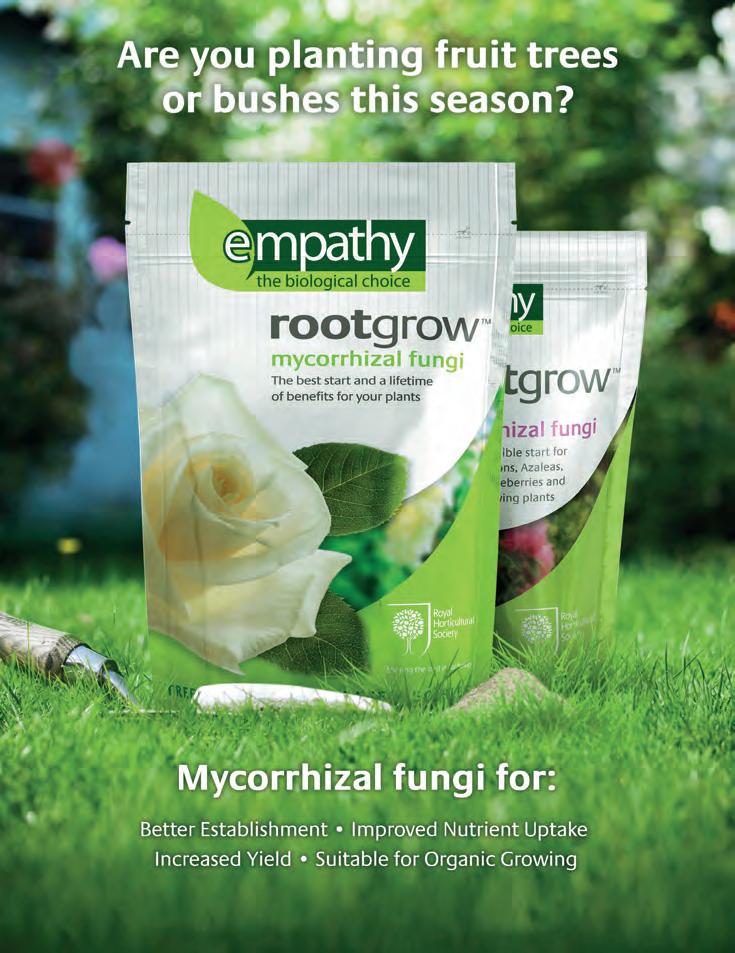
We produce and grow the largest selection available in the UK. Plants are pot grown and suitable for garden, patio or bonsai. Send SAE for descriptive catalogue. Visitors welcome Mon-Sat 9am-1pm & 2pm-4.30pm Barthelemy & Co (DCG), 262 Wimborne Rd West, Stapehill, Wimborne, Dorset BH21 2DZ Tel: 01202 874283 enquiries@barthelemymaples.co.uk www.barthelemymaples.co.uk JAPANESE MAPLESAcer palmatum varieties Northcote Hill, Honiton, Devon, EX14 9TH Tel: 01404 43344 'Growing in Devon since 1957' • Native, Formal & Evergreen Hedges • Screening • Woodland • Specimen Trees • Gardens Large range of ornamental and fruit trees Trade discount available • Delivery available Growers & suppliers of native & ornamental trees, shrubs & hedging for: Order online at www.perriehale.co.uk Email: faye@perriehale.co.uk Pococks Roses Visit us for all that’s best in roses at either: BRING THIS ADVERT IN FOR A 10% DISCOUNT Tel: 01794 367500 or 01872 519146 Open: Monday-Friday 10-4 www.garden-roses.co.uk sales@pococksroses.co.uk POCOCKS ROSES, JERMYNS LANE, ROMSEY, HAMPSHIRE SO51 0QA THE CORNISH ROSE COMPANY, MITCHELL LANE, MITCHELL, NEWQUAY, CORNWALL TR8 5AX or Autumn - nature’s time for planting roses • Environmentally friendly • Easier on the pocket • Guaranteed to flower next summer NEW CATALOGUE FEATURING SOME STUNNING NEW INTRODUCTIONS NOW AVAILABLE adamsappletrees.co.uk sales@adamsappletrees.co.uk AVAILABLE ONLINE OR FROM ANY GOOD GARDEN CENTRE rootgrow.co.uk www.countrygardener.co.uk 11
This fast, e
cient solution transforms your conservatory into a comfortable year round living space. Exclusive to Conservatory Insulations, the UK market leader, this Conservaheat layered foil quilt system comprises technology developed by NASA for the Space Shuttle programme
This fast,
cient solution transforms your conservatory into a comfortable year round living space. Exclusive to Conservatory Insulations, the UK market leader, this Conservaheat layered foil quilt system comprises technology developed by NASA for the Space Shuttle programme
The outer foil of our quilt incorporates a unique True Aluminium Foil, speci
This fast, e




The outer foil of our quilt incorporates a unique True Aluminium Foil, speci
cient solution transforms your conservatory into a comfortable year round living space. Exclusive to Conservatory Insulations, the UK market leader, this Conservaheat layered foil quilt system comprises technology developed by NASA for the Space Shuttle programme
for you is it helps maximise heat retention Suitable for all roof styles, it is a cost-e
cally designed for conservatories. The benefit for you is it helps maximise heat retention Suitable for all roof styles, it is a cost-effective solution which insulates your conservatory for a fraction of the cost of a new tiled roof.
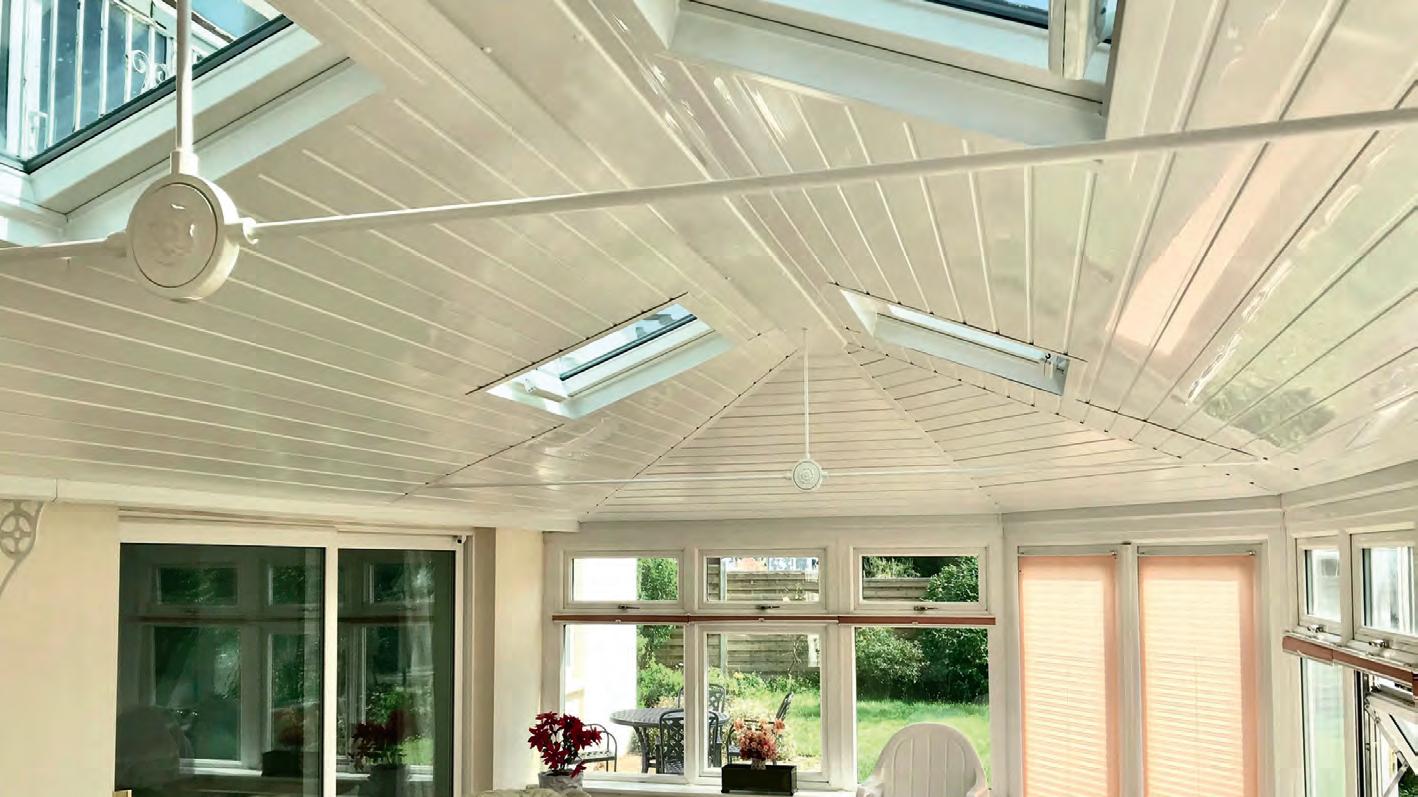

cally designed for conservatories. The bene
ective solution which insulates your conservatory for a fraction of the cost of a new tiled roof
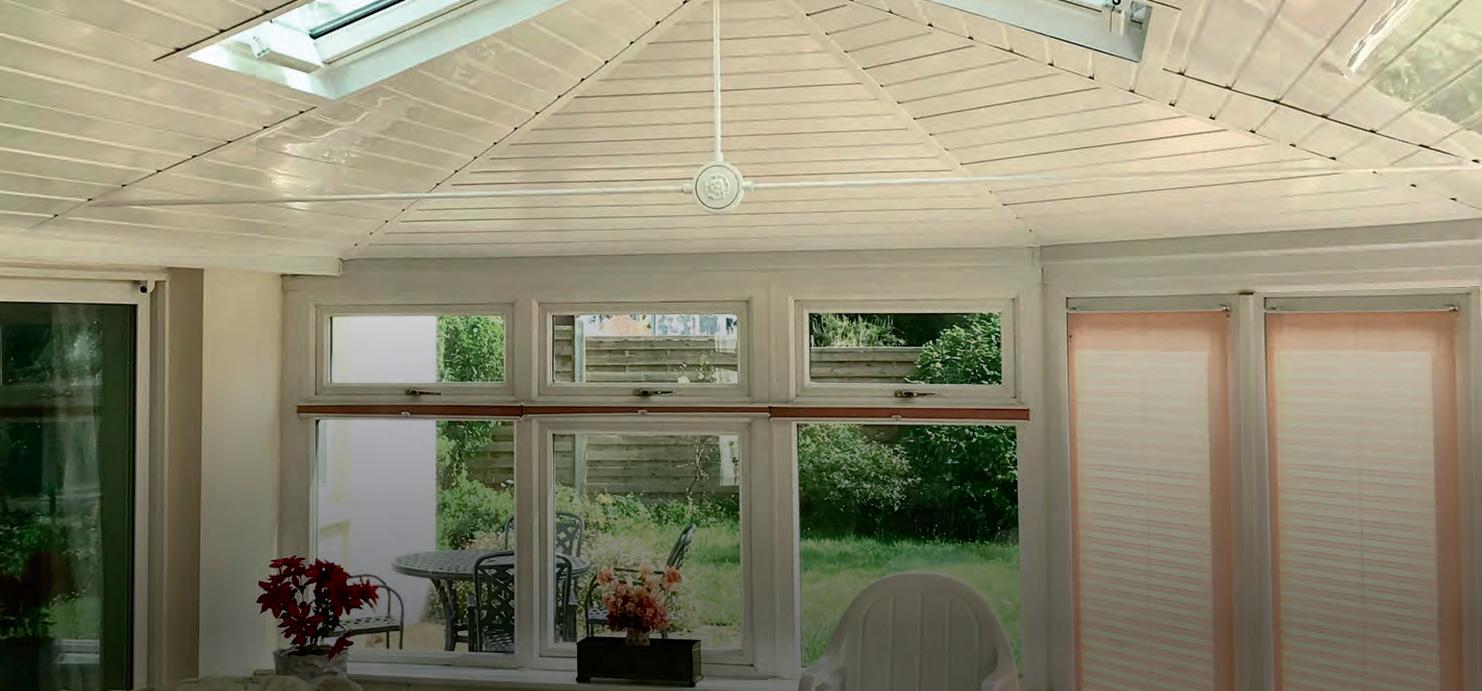




The outer foil of our quilt incorporates a unique True Aluminium Foil, speci

cally designed for conservatories. The bene





With this proven energy-saving product you and your family can relax in complete comfort all year round
t for you is it helps maximise heat retention Suitable for all roof styles, it is a cost-e



With this proven energy-saving product you and your family can relax in complete comfort all year round
ective solution which insulates your conservatory for a fraction of the cost of a new tiled roof.
With this proven energy-saving product you and your family can relax in complete comfort all year round

Country Gardener12 THE UK’S MARKET LEADER BUY NOW PAY 2023 • Cooler in summer • Warmer in the winter • Prevents UV fading • No VAT to pay • Proven energy saver • Eliminates external noise Enjoy your Conservatory whatever the weather FREEPH ONE 0800 180 400 0 Text ‘Quote’ to 60777 www.conservatory insulations.com
effi
fi
fit
ff
THE UK’S MARKET LEADER AS S EEN O N 0% VAT! CGOCT BUY NOW PAY 2023 • Cooler in summer • Warmer in the winter • Prevents UV fading • No VAT to pay • Proven energy saver • Eliminates external noise Enjoy your Conservatory whatever the weather FREEPH ONE 0800 180 400 0 Text ‘Quote’ to 60777 www.conservatory insulations.com
ffi
fi
fi
ff
THE UK’S MARKET LEADER AS S EEN O N RECOMMENDED BY 0% VAT! Please quote code CGOCT SPECIAL READER OFFER 20OFF % BUY NOW PAY 2023 • Cooler in summer • Warmer in the winter • Prevents UV fading • No VAT to pay • Proven energy saver • Eliminates external noise Enjoy your Conservatory whatever the weather FREEPH ONE 0800 180 400 0 Text ‘Quote’ to 60777 www.conservatory insulations.com
ffi
fi
Harvest time and storing fruit and veg
A. You can still get the tomatoes to ripen indoors. Contrary to what we might think, green tomatoes do not need sunlight to ripen. It is better to keep them in a dark place with little light. Placing a ripe banana or apple in with some green tomatoes in an enclosed space helps to speed up the ripening process. Don’t be tempted to wash them before getting them to ripen – this can encourage mould to develop. You should, of course, wash them before eating, though. You can dice and cook them to make chutney.
Q. WHICH CROPS WILL STORE FOR LONGEST?
A. Unless the ground is needed for other crops, most root vegetables on well-drained soil can be left in the soil over winter. However, this does leave them vulnerable to cold damage and is not recommended on wet soils.
Pumpkins and squash, all root vegetables including potatoes and carrots , apples and pears will all store for long periods.
Leafy crops have a much higher water content and are therefore not good to keep. Carrots for example can be left in the ground until needed. To make digging up easier, cover the ground with a 15cm layer of straw, cardboard or bracken held down with netting or horticultural fleece. These will keep until March if necessary.
Q. WHICH FOODS SPOIL THE QUICKEST
A. There’s a significant list of vegetables which you will have to take fairly quick action on. Green beans, kale and the like will not keep, tomatoes and all berries will need to be frozen for later.
Q. HOW LONG WILL MY GLUT OF POTATOES KEEP FOR?
A. Potatoes and sweet potatoes will keep for weeks at room temperature, but in a cool, dark, dry, and ventilated space, they’ll last far longer—a month or so for sweet potatoes and up to three months for white potatoes. Store potatoes unpeeled and loose. They need airflow to prevent the accumulation of moisture, which can lead to spoilage. The best way to allow free circulation of air is to store them in an open bowl or paper bag. Do not store them in a sealed container without ventilation.
Q. I HAVE TRIED FOR SEVERAL YEARS TO STORE APPLES THROUGHOUT THE WINTER BUT I ALWAYS SEEM TO LOSE AT LEAST 50 PER-CENT OF THEM.
A. This isn’t a job to be rushed, Apples can be stored in the fridge for a week but if you are looking to store them over the winter wrap each one in a single sheet of newspaper and place them in single layers on a tray, preferably with the stem on. Check the apples periodically and remove any that are spoiling. Use the large ones first because they tend to get soft before the smaller ones. Apples continue to ripen in storage, so place each variety on its own tray because they ripen at different rates.
Q. HOW CAN I PREVENT A GLUT OF VEGETABLES?
A. If you have more vegetables than you need from your garden then you need to gear up for a proper storing strategy. Storing for later is sensible and economic.
Many fruit and vegetable crops can be preserved in a range of different ways.
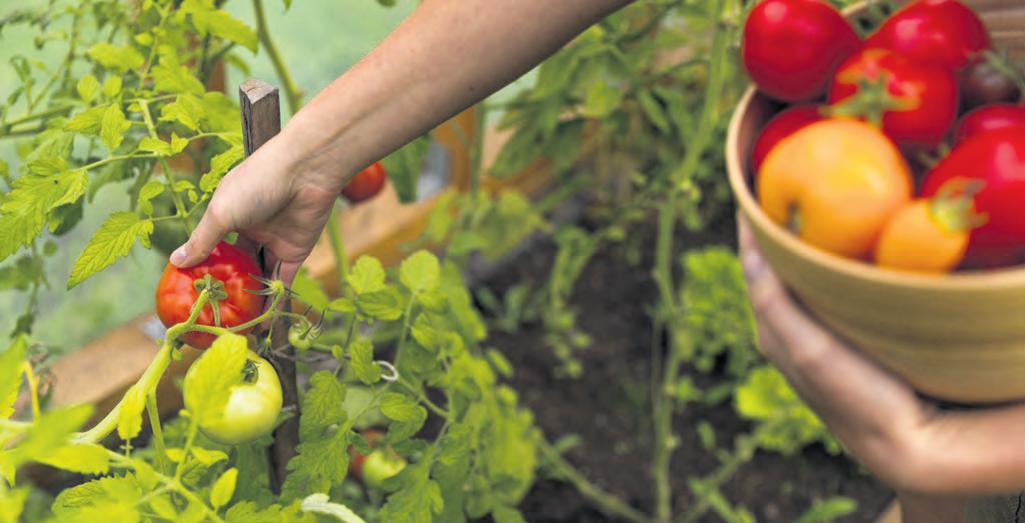
It’s really satisfying to see your shed, cupboards and freezer stocked up with home-grown produce, and it will also save you money, helping to feed the family through the leaner, colder months.
It’s important to pick all fruit and vegetables in their prime and discard any that are damaged in any way. Chill perishable crops, such as berries and stone fruits, if you can’t process them straight away.
Several root veg and top fruits can be stored in a cool, well-ventilated spot, such as a shed or garage. Don’t store root crops in a very dry place, or they will shrivel. Use within six months.
Dry potatoes in the sun to harden the skins, then store them in hessian sacks in a dark place. Regularly check for signs of rot.
Wrap unbruised apples in newspaper and store them in boxes in the shed.
Currants and raspberries: open-freeze currants on their stems and berries on trays before bagging.
Q. I HAVE A GLUT OF BEETROOT THIS SUMMER AND I’D LIKE TO BE ABLE TO STORE IT.
A. Beetroot will keep in the refrigerator for between one to three months. If there is no room in the refrigerator, they can also be packed in a container—a bucket or plastic storage box or cooler–in moist sand, moss or sawdust.
Remember you can freeze beetroot for up to 12 months. You can freeze it both raw (but blanched) and fully cooked, depending on how you plan to use it .
Q. HOW DO YOU STORE PEARS LONG TERM?
A. Simply place the whole pears in a perforated plastic bag or a paper bag and put them in your refrigerator’s cooler drawer. They will last up to two months in cold storage, while unripe summer pears may last up to a week in the fridge. Two varieties of pear, ‘Conference’ and ‘Doyenne du Comice’, just happen to be the best for storing. They need to be picked hard, green and under ripe. Do not wrap the fruit, but lay them out in dimple cardboard trays, so they are easy to inspect. Since pears can deteriorate very quickly, it is essential that you regularly check them and remove any that are showing signs of deterioration. A few days before you want to eat the pears, bring them into a warm room indoors and place them on the fruit bowl to ripen.
Pears stored in ideal conditions should last for up to four months.
AUTUMN OFTEN BRINGS WITH IT A GLUT OF CERTAIN FRUITS AND RAISES THE PROBLEMS OF HOW TO STORE FRUIT AND VEG. HERE ARE SOME OF THE MOST COMMON QUERIES.
Q. I STILL HAVE LOTS OF TOMATOES WHICH I DON’T THINK WILL RIPEN NOW. WHAT ARE MY OPTIONS?
www.countrygardener.co.uk 13
Celebrating great tasting apples
Devon apple expert Simon Cadd shares his 30 years growing experience by putting taste at the top of the list as he urges us all to grow more apples in our gardens
I am always being asked what apple tree gardeners should opt for. We all know the choice is bewildering with thousands of varieties in front of us.
I encourage everyone to grow more apple trees and this autumn is no different.
Which one depends on if you want to support local varieties, what sort of apple you want but most important what taste do you prefer.
Planting a new apple tree is a long-term investment. It will take at least two years before your new tree produces fruit and up to ten years to reach full size. So, I urge anyone thinking of adding a new apple tree to spend some time choosing the right variety for your needs and circumstances.
There is a quick list to check.
• What will be the taste of the apple you are planning. Don’t grow apples you will not enjoy.
• Do you have the pollination right to allow the fruit to set.
• How big will the tree be when it reaches maturity.
Some of the best flavoured apples are notoriously difficult to grow for beginners. I am thinking of Cox’s Orange Pippin! Widely regarded as one of the finest tasting apples, it is very susceptible to scab and canker, giving poor results.
This can be frustrating if it is your first foray into growing your own.
Another factor to think about is harvesting time.
Different varieties ripen at various times: some early varieties are ready in late August and some lates into early November. This is of special importance in school orchards where varieties need to be selected that will be ready for picking in school term time.
We often see school orchards that are at their peak during the summer holidays and fruit must be cleared away by grumbling caretakers, never reaching the children’s hands or mouths.
You also need to consider use and keeping time. Some apples don’t develop their taste fully for a couple of
months after they have been picked so are more suitable for storage, while others need to be eaten straight away.
There are thousands of known apple varieties, how do you narrow it down to such a condensed list? Because taking into account the above qualities discounts the huge majority of them! It’s no use having a ‘perfect’ growing variety that never gets disease and gives you tons of fruit every year but tastes like chewing on a lump of plywood thus you never use most of them… and on the reverse side of the coin it might sound great to have some long-forgotten timeless treasure with a to-die-for flavour but which only gives you three scab-ridden apples every now and again, when it feels like it!
Combining all those virtues may be almost impossible to find in any variety and of course many cultivars will
continue to be cultivated on specific merits. But the ten I’m about to give you go as far as it’s possible in attaining the title ‘perfect garden apple’.
Flavour is usually the most important consideration for most gardeners. Organised autumn ‘apple tasting’ events are a useful way to determine favourites.
Unfortunately imported cultivars sold in supermarkets are from warmer countries, and have a different flavour when grown in Britain, even if they grow well, which is often not the case.
The majority of fruit cultivars are developed by crossing two known parents and this allows the offspring to inherit certain flavour characteristics. If you know the parentage, you can get an idea of the flavour.
Types of apples - basic principles
If you are planning your own orchard, or just a few trees in the garden, you need to decide what to plant.
The most reliable trees from the cropping point of view are apples. Secondly, which apple variety suits you best? You may want a variety. You may not want the apples to ripen at the same time. The choice all comes down to a few elementary principles.
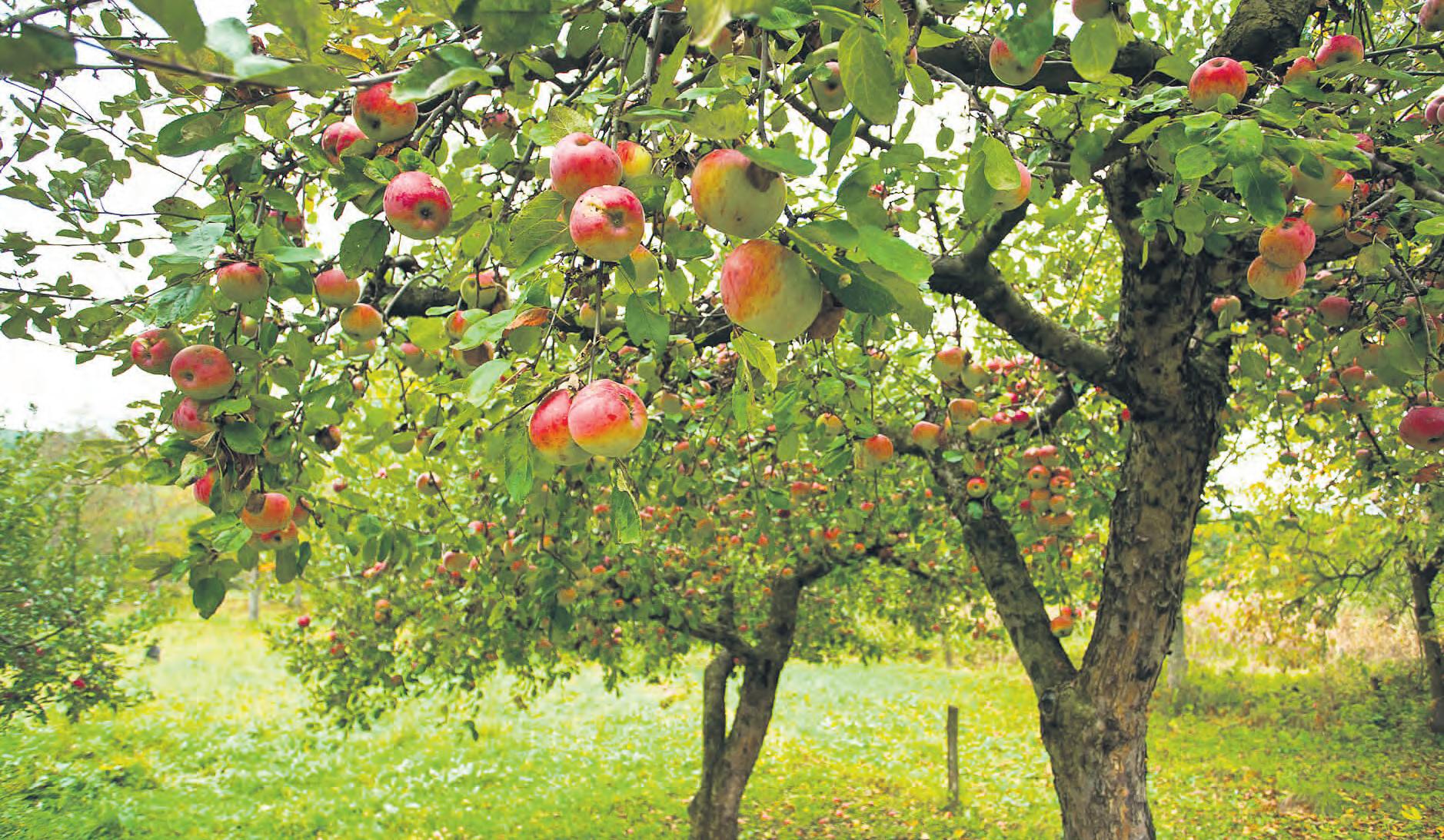
1. All apples, picked when mature, will become sweet. Some are by nature sweet when it is harvest time. Others have a degree of sharpness at harvest time and will retain their sharpness longer. Therefore if you plant more than one tree, it is best to choose different varieties. In that way your fruit will not all ripen at the same time. At harvest time, all apples are crisp. However the late maturing apples keep their crispness the longest.
2. All apples will cook. However some apples are better suited than others. The same applies to baking and apples used for slicing. Some apples will retain their shape when baked, others go to mush.
3. The best apples for keeping are the late maturing apples, picked in October, some even in November, particularly the smaller sized apples. However, always keep them in a dark place, which should be the coolest possible.
Growing for success
• Go for natural disease resistant varieties where possible.
• Plant two apple trees from the same pollination group to improve cropping or grow self fertile varieties.
• Thin the fruitlets in July leaving the healthiest apples on the branches - you’ll get fewer fruits but they’ll be top quality.
• Keep an area of soil free from weeds to boost growth and reduce competition.
• Feed trees every spring with slow-release fertiliser.
GROWING FRUIT SPECIAL Country Gardener14
1. ‘Chivers Delight’
This is a late flowerer and cropper referred to as a ‘Cox Plus’.
It has as much flavour (if not more) than ‘Cox’s Orange Pippin’ and better acidity, which it keeps in storage. Cox famously go woolly quickly in storage, whereas the flesh of ‘Chivers Delight’ remains firm and nutty. This fell out of commercial favour because of its colour irregularity. If the sun is on it, the fruit goes red, but it will not colour up on the shady side. This does not affect the flavour but makes them difficult to sell.
2. ‘Spartan’
Nothing has the same richness of colour as ‘Spartan’, a lovely deep plum red, with almost bright white, contrasting flesh. It’s a beautiful apple, which stays late on the tree and makes a fabulous eater with very juicy fruit. It’s a good storer, is widely available late in the year.
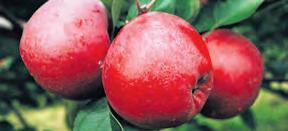
3. ‘Blenheim Orange’
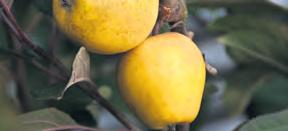
A fabulously aromatic, peppery, almost spicy apple with a softer nuttiness than you get with the similar-flavoured ‘Egremont Russet’. This variety is a bit prone to scab, so is best grown on its own and certainly away from very scab-prone varieties such as ‘Crispin’.
4. ‘Egremont Russet’

A famous apple with a wonderful nutty, woody texture and a very characteristic taste, floral and heady, so you can almost smell the blossom. It stores well, with the flavour deepening to honey.
5. ‘Pitmaston Pine Apple’
This is a very unusual apple, difficult to find but well worth the effort. It eats like a ‘Greensleeves’ early on, but you can store it until April when the flavour morphs into pineapple.
6. ‘Greensleeves’
A light, crispy, full-of-flavour apple, lovely and crunchy straight off the tree. This is the one ‘Golden Delicious’ aspires to be, with excellent flavour in a beautiful pale yellow fruit.
7. ‘Worcester Pearmain’
A rich, creamy apple with a strong flavour, one of the original varieties brought over by the Normans. It’s just about surviving in the UK, but you don’t see it often, apart from in the Wye Valley where it’s usually pressed into juice.
8. ‘Howgate Wonder’
A great all-rounder apple – a good cooker early on, it also presses well and mellows the later you leave it, with the acidity dropping away, so it can be eaten as a dessert apple from the store or tree. It’s one of the few varieties where you can leave the fruit on the tree, start harvesting in August and carry on until the end of October at least. It performs well whatever the weather.
9 ‘Herefordshire Russet’

Is a true russet – it has a fine rough golden skin with just a few cinnamon red patches developing here and there. Flavourwise it combines that distinct nutty russet taste with an added depth, an added slightly sharp aromatic quality – a bit like a Cox crossed with a russet. The reason this new[ish] variety outranks others is that it flowers later, thus avoiding early frosts, the fruits are larger, and the flavour even better, and it’s also self fertile – the only russet that is. ‘Herefordshire Russet’ is already appearing on our best sellers list, and rightly so.
10. ‘Discovery’
There’s definitely a reason why it has risen to become the foremost early in the UK for well over 50 years now. Discovery is an Essex raised variety and it first became known in the 1930s. The fruits are flat-oval in shape and predominantly red over a pale green/yellow ground. The flavour is superb, refreshing and slightly sharp but not offputtingly so. In common with all earlies it should be eaten straight from the tree to enjoy it at it’s best; when kept after picking it quickly loses it’s sparkle. Season August to early September. Does well grown with all systems and cultivation methods.
Can you plant just one apple tree?
One tree is not enough. To set fruit, most apple trees require a different variety grown nearby for pollination. While some apple varieties are self-pollinating, even they produce more fruit with another variety nearby.
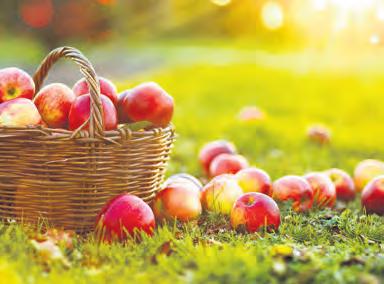
How do you prepare soil for apple trees?
First, you will need to dig a hole three times the width of the size of the pot, and just as deep as the root ball. The dirt that you have taken out of the hole should be well mixed 50/50 with aged mushroom compost, rotten pine bark, aged manure or compost.
What are the best late fruiting apples say into November?


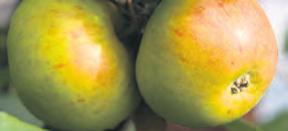

There are a few that will fruit into November but none into December. The season just catches up on them. Laxton Superb is an apple known for its late fruiting.
Should new trees be pruned in the first year?
Maiden trees do need some attention after planting and before they come into leaf. Reducing the growth by 30 cms to a bud will encourage cropping branches lower down the tree.
The leaves on the young shoots of my apple tree are curled and sticky. What has caused this?
The shoots are infested by aphids. Several species can affect apple trees – some species leave the tree in summer to find other host plants, whereas others remain on the tree. The sticky substance is honeydew produced by the aphids, and this can lead to the growth of sooty moulds. The uncommon rosy leaf-curling apple aphid causes leaves to become distorted and red. Rosy apple aphid is a frequent pest and causes yellowish green curled leaves; it can also affect the fruit.
How do I encourage my apple tree to produce fruit?
An apple tree without fruit may not be getting enough sun or water. Poor fruit production can also be caused by over fertilising. Provide a three inch layer of mulch around the tree, but not touching the trunk, for protection and moisture retention.
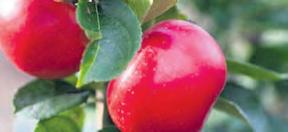
Do apple trees need fertiliser?

All trees should be fertilised in spring, before June. Young apple trees -one to three should grow a foot or more per year. If they are growing less than that, increase the fertiliser in subsequent years by 50 per cent.

My choice of tasty apples Apple growing Q&A 1 6 2 7 3 8 4 9 5 10 www.countrygardener.co.uk 15
The delights of growing pears
Pears are a wonderful addition to a garden, versatile, easy to grow, the biggest problem is timing exactly when they are ripe and ready to eat
There is a story about a pear enthusiast who sat up all night for the delight of tasting a pear at the precise moment of perfect ripeness.
It isn’t an easy thing to achieve. Pears ripen from the inside out, so a fruit that is fully ripe on the outside may already be overripe near the core. Ideally you need to place them in a fruit bowl to ripen up for a week or so at room temperature, and check them daily for ripeness. They should yield slightly if you press gently on the stem end.
Growing pears is a particular delight in the garden. If you have a love for pears, it’s worth growing two or three. They make an excellent tree with beautiful blossom, or they can be trained against a wall or grown in containers.
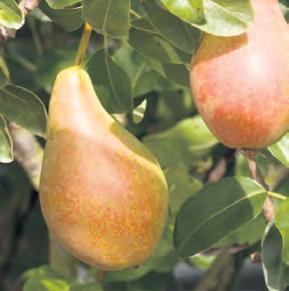
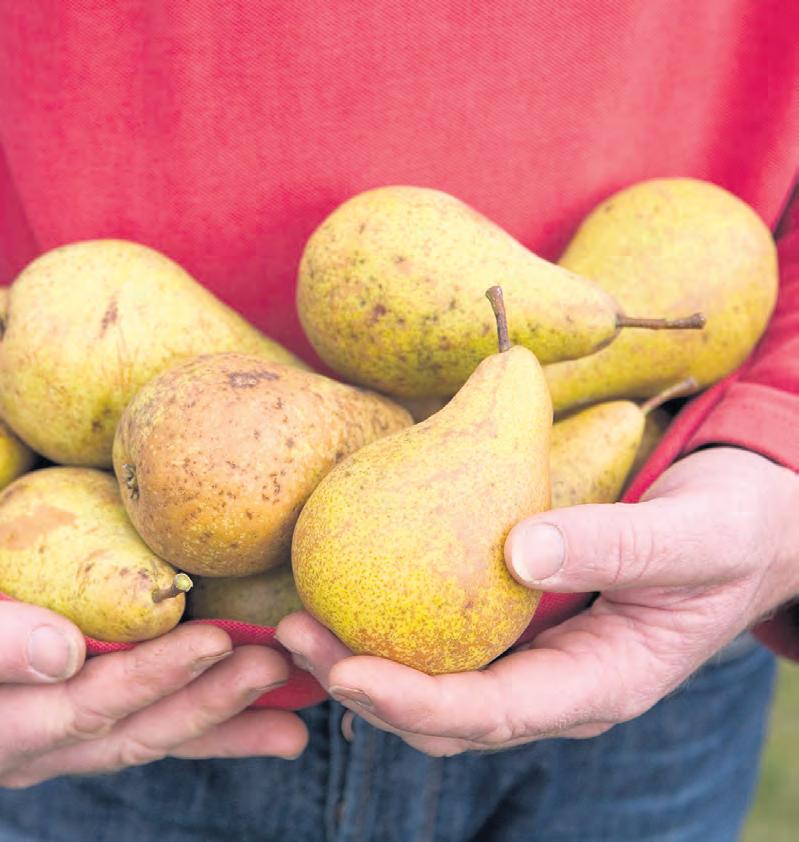
European pears (Pyrus communis) fall into three categories: culinary, dessert, and perry pears. Many people believe it’s not worth growing pears that are meant specifically as cookers, because most dessert pears are really dual-purpose fruits that are just as good cooked as they are eaten raw.
Perry pears are ideal for making a dry pear cider, which was once regarded as equal to the finest of wines.
When planning your fruit garden, keep in mind that you’ll almost certainly need at least a pair of compatible pears for good pollination.
The earliest pear varieties fruit in summer, with mid-season varieties ripening in late summer. Most pears are ready to pick from early autumn, but they can be left on the tree until hard frosts are forecast, then ripened off the tree.
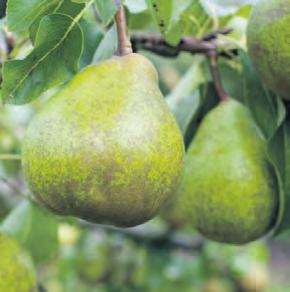
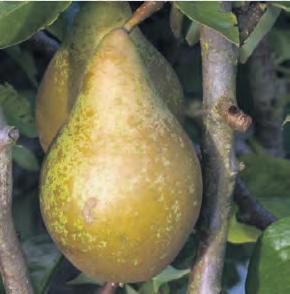

The ideal position for a pear tree is a sunny, sheltered site, well away from any frost pockets. Avoid poorly drained or shallow soils.
You will see pear trees for sale in two forms: bare root stock forms where the roots are exposed when you purchase them or in containers. Bare-root plants should be planted from late autumn onwards, containerised plants can be planted at any time of year, although winter is ideal.
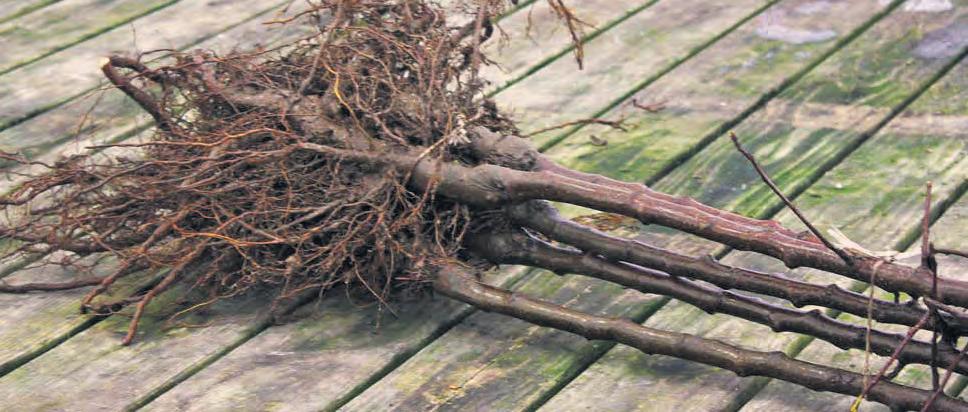
Pears are hardy and will grow well in many areas, but they do need a little cossetting in cooler regions. The flowers appear early and are easily damaged by frost so it’s best to grow them somewhere sunny and sheltered, but not in a low-lying area that could become a frost pocket. If your garden is cold, try training them against a sun-facing wall where the radiated heat will help protect the blossoms if there’s a cold snap. Pear trees take well to being trained as cordons, espaliers or fans.
Pears will adapt to most soil conditions but they do prefer a rich, slightly acidic, loamy, well-drained but moisture-retentive soil.
Keep newly planted pears watered while they establish, and treat them to a mulch of organic matter such as compost, well-rotted manure or leaf mould once year. Give them a boost with poultry manure pellets every few years; an occasional liquid seaweed feed makes a good tonic too.
Planting in containers
If you want to grow a pear in a container you must choose one that has been specially grown for it. Pear trees are not grown on their own roots. The top of the tree is grafted onto different roots (called a rootstock), and the roots control the size of the tree. Therefore, when you are choosing a pear for a container you must make sure it is grafted onto a container rootstock. Look out for rootstocks called ‘Quince C’ for a container. Choose a container that is two feet in diameter. When planting, place some crocks (small pieces of broken concrete or clay) as drainage is essential.
Problems with pears
BROWN ROT is a fungal disease causing a brown, spreading rot in fruit, sometimes with white pustules of fungi on the surface. It is usually worse in wet summers. Remove all rotten fruit as soon as you see it and destroy, this will prevent the spread of the rot.
PEAR RUST is a disease causing bright orange spots on the upper surfaces of pear leaves in summer and early autumn.Remove all infected leaves as soon as you see them and destroy, as this will prevent the spread of the rust. There is no chemical control.
‘Doyenne du Commice’
‘Gorham’
‘Conference’
Pears ripen from the inside out
Bare root pear trees should be planted from October
GROWING FRUIT SPECIAL
Country Gardener16
TOP TEN FRUITS for a small garden
If you have a small outside space you may not often think about growing fruit but dwarf fruit, espalier trees and containers open up a whole range of fruits to grow


If you’re short on space, growing your own fruit may seem like a daunting task. However, armed with the right equipment, and the right selection of the top ten best fruit for small spaces, your ideas for small gardens can come to fruition and have you growing blueberries, blackberries, and everything in between.

Fruit is a wonderful great option for small gardens, patios and balconies. It provides you with homegrown pickings, looks attractive when it’s in flower and when the crop is ripening.
Fruit trees and bushes can be used to create a framework in your garden – their trunks and branches doing the same job as ornamental trees and shrubs, but with the added benefit of being productive each year.
Small gardens can accommodate an apple, pear or plum tree – all of which are clothed with beautiful blossom in the spring.
Walls and fences provide sheltered conditions for trained fruit trees and bushes, which can be pruned to restrict their size, create attractive shapes and most importantly, maximise the crop. Patio or dwarf fruit trees make good trees for pots or a border or kitchen garden and will remain compact.
1. Blueberries are perfect for small gardens as they need little space and thrive in sun or part shade and are easiest to grow in ericaceous compost, in large pots. The fruit ripens over a long period, from July to September. The fruit is ideal for large containers, where they flower and fruit freely, bearing delicious berries that can be eaten as they are, or saved for later use in recipes and when space is tight you can opt for smaller varieties such as ‘Bluetta’ and ‘Top Hat’.
6. Autumn raspberries - tolerate part shade and any soil, except soggy soil or chalk. They crop on the current season’s growth between August and October. Raspberries can be grown directly in the soil or in large pots. Autumn raspberries generally don’t need support, as they’re shorter than summer varieties and crop on the current season’s growth, making them an ideal and compact fruit for small gardens. Eat when ripe or save some for cooking and baking to really make the most out of your crop. Autumn varieties: ‘Joan J’, ‘Zeva’ and ‘Autumn Bliss’.
2.
Redcurrants and whitecurrants thrive in containers, meaning that they are perfect for smaller gardens and grow a lot of fruit and need little attention –making them perfect for the busy gardener. They are an excellent good option for a shady spot, although the flavour will be better in sun. Prune back new shoots in July to encourage fruit spurs. Most varieties ripen in July.Reliable varieties: ‘Junifer’, ‘Jonkheer van Tets’ and ‘Rovada’.
3. Apples-whilst you may imagine apple trees to be enormous, special dwarf rootstocks are now available and hugely popular. Tree size and how early it will produce fruit varies depending upon the rootstock, so shop around to find the perfect variety for your small garden. The apple tree care and pruning routine becomes more manageable with this smaller fruit tree, and you can also train apple trees against walls or fences.
4. Pears, like apples, are often grafted onto quince rootstocks, to prevent them growing too tall. The ‘Concorde’ variety of pear is particularly well suited to small gardens, and pears can offer a tasty and unusual addition to your garden. Whilst like apples, pears need more warmth and sunshine and are more susceptible to frosts, so make sure to protect them when needed.
7. Figs thrive in pots and will produce more fruit and less foliage if they are planted in containers. Planting in containers restricts root growth so that the tree does not grow over-large, and fig trees in containers are best grown as dwarf half-standards. Be sure to keep the pot well-watered, and each spring top-dress with fresh soil mixed with some slow-release general fertiliser to keep your figs going.
8. Japanese Wineberries can be easily restricted to grow in small spaces by training the stems along canes or looping them into figures of eight. Wineberries fruit on stems from the previous year, so you’ll have to wait a while before you can try your fruit. You’ll be rewarded for your patience: these unusual berries are small, but sweet and juicy.
5.
Rhubarb needs an open, sunny site with moist, but free-draining soil, as it dislikes being waterlogged in winter. However, it doesn’t need a lot of space and if you can find four or six feet of space that will be enough for two crowns. Avoid planting in sites that are particularly prone to late frosts, as the young stems may be damaged. Rhubarb can be grown from seed, but it’s more common to plant dormant crowns between autumn and spring. Allow to establish for a couple of years before pulling. Most varieties crop from April to June. Proven varieties: ‘Timperley Early’ and ‘The Sutton’.
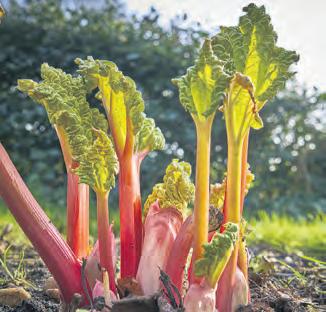
9. Grapes are no longer exclusive to hot countries, with new modern varieties of grape available to grow in your small garden and varieties including ‘Dornfelder’ and ‘Regent’ being particularly well adapted for colder regions. Alternatively, grapes can be grown in a greenhouse or a warm, sheltered spot in the garden. These are great to train along a wall, but make sure to keep on top of the pruning.
10. Gooseberries can be very successful in pot or up against a sunny wall so again ideal for smaller spaces. They like sun for at least half the day. Improve thin, sandy soils with well-rotted compost. Leave to ripen for sweet flavour. Crops from June to July.Delicious varieties: ‘Leveller’, ‘Invicta’ and ‘Captivator’.
Remember for smaller gardens, apples, pears, gages, plums, damsons and cherries are all available as self-fertile Minarettes. These bear fruit on short spurs along the length of a vertical stem, and many can be grown in patio pots.
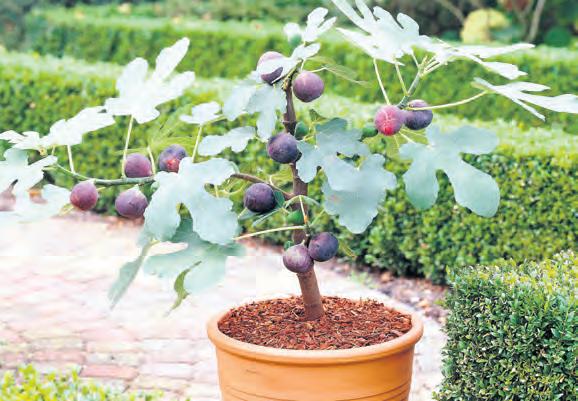
GROWING FRUIT SPECIAL www.countrygardener.co.uk 17
GOLDEN COLOURS OF DAYS OUT IN OCTOBER
The colours of autumn are a huge attraction and this year promise wonderful days out as gardens change their colours from the vivid summer hues to the browns and golds of October and November.
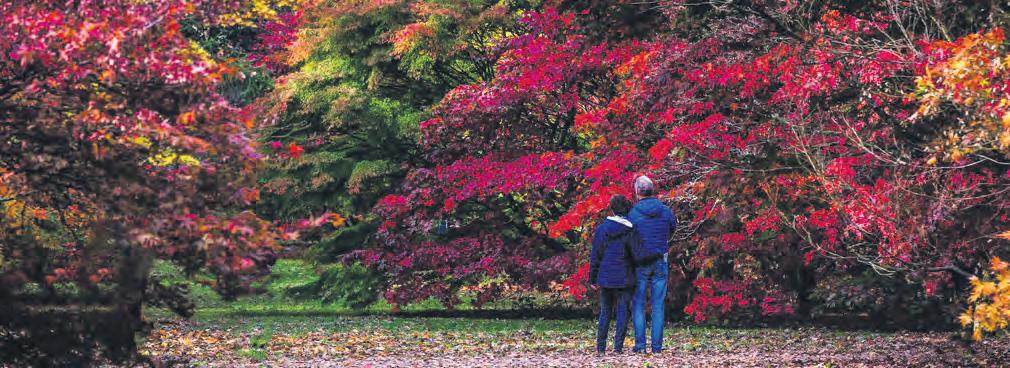
The South West has some wonderful gardens and arboretums which come into their own as the days shorten and get cooler. Batsford and Westonbirt Arboretums both have magnificent collections of trees producing vibrant reds, browns, and yellow, and perfect walking venues. There is still enough light in the days to get out and about for holidays and shopping trips as well as traditional garden visits before winter descends.
Autumn colour spectacular at Batsford Arboretum
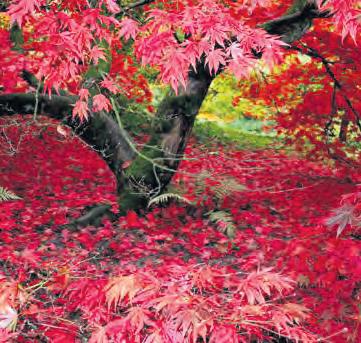
Batsford Arboretum is famed for putting on a showstopping display of autumn colour, thanks to the magnificent collection of Japanese maples, sorbus, euonymus and cherries. Visitors can enjoy 56 acres of magical walks amongst a kaleidoscope of reds, pinks and golds against the backdrop of stunning Cotswolds countryside.
There’s also the opportunity to browse the selection of gardening essentials in the extended garden shop and the huge choice of quality plants in the walled garden plant centre before lunch or afternoon tea in the newly refurbished Garden Terrace Café.
Pre-booking is essential for arboretum visits in the autumn at www.batsarb.co.uk Tel: 01386 701441.
Batsford Arboretum & Garden Centre, near Moreton-in-Marsh, Gloucestershire, GL56 9AT
SEASONS GREEN OFFERS GIFT WITH CLASS AND STYLE

Corfe Castle is one of the most iconic landmarks in Dorset, but did you know it’s surrounded by a pretty village with the same name?
From the castle you can see the village laid out like a map below, with its church, pubs, cafes, galleries and shops. A favourite of these is Seasons Green, full of gorgeous items inspired by plants, flowers and the English countryside. It is well known for the selection of unusual gifts, art, and crafts, and like the village itself is a chocolate-boxpretty shop full of character.
Autumn at Seasons Green - Velvet Pumpkins from £3.75, Foraging Fox Linens from £7, Pumpkin Bunting £7, Handmade Leaf Wreath £32, Pheasant cushion £49. www.seasonsgreen.co.uk Tel: 01929 477 228

BOSCREGE, A TRUE CORNISH EXPERIENCE
Boscrege Caravan and Touring park in Cornwall is a peaceful and picturesque park, set at the foot of Tregonning Hill, Godolphin National Trust and amongst a myriad of Cornish lanes in an area of outstanding natural beauty. The park, which is open all year through, is situated close to the wonderful Cornwall coast and only a few minutes drive to Praa Sands, one of Britain’s nicest beaches. St Ives, Penzance, Hayle and Lands End, So, if you are looking to take a luxury holiday (doggie friendly with dog friendly homes and on site designated fields for the dogs too) in Cornwall in a either a self catering caravan, lodges touring or even purchasing your very own holiday home then contact Boscrege Caravan and Touring Park. And new this year, an development of single/twin lodges available to buy with a 20 year site licence and two years free site fees. Come and see with a two night free stay available for genuine buyers.
Boscrege Caravan Park, Boscrege, Ashton, Cornwall TR13 9TG Tel: 01736 762231 www.caravanparkcornwall.com
Tranquillity, autumn colours and warming soups at Lukesland Gardens

Tucked away on the southern edge of Dartmoor, just north of Ivybridge, Lukesland is a wonderful place to enjoy autumn colour. The shelterbelt of beeches, planted by the Victorians to protect this 24-acre garden from Dartmoor winds, turns to gold, while more exotic species such as acers, cercidiphylum, cornus, enkianthus, ginkgo and swamp cypress reflect their autumn tints in the pools of the Addicombe Brook. Visitors often comment on how peaceful the garden is, with the gentle sound of the tumbling stream constantly in the background, as you wander on twisting paths through this woodland valley, with new views around every corner.
Openings are on Sundays and Wednesdays 11am to 5pm from 2nd October to 13th November. No prebooking is required. The tea room is open with a simple menu of homemade soup and cakes. Contactless payment is preferred in the tea room and at the gate. Dogs are welcome on a lead.
For more details about Lukesland phone 01752 691749 or go to www.lukesland.co.uk or www.facebook.com/ lukeslandgardens
Autumn, at Westonbirt Arboretum
Over 15,000 trees will soon be putting on one of the world’s most spectacular natural colour shows at Westonbirt, the National Arboretum this autumn. Visitors can see a dazzling display of vibrant reds, yellows, oranges and purples and experience nature’s very own firework display.
In October, you can explore the ‘Disappearing Trees’ trail. All of us appreciate trees, but how many of us know that some trees are threatened and in danger of disappearing?
Westonbirt currently has 100 threatened trees in its collection. This trail introduces 10 of them.Led by experienced and knowledgeable guides, you can also find the best seasonal features of the Old Arboretum. Westonbirt, The National Arboretum is managed by Forestry England and is renowned worldwide for its tree and shrub collection.
For all this and more information on the next event, Enchanted Christmas, see Forestryengland.uk/westonbirt
GREAT PLACES TO VISIT
Country Gardener18
offer special all counties prices when advertising with our features, plus 100 words of free editorial with an advert.


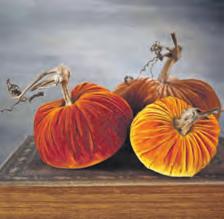
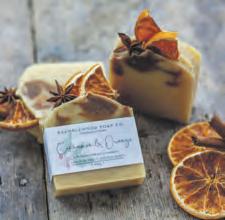




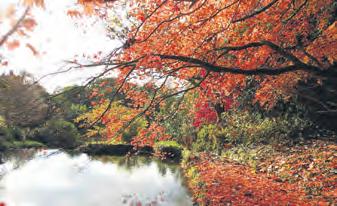


to one of our sales people for more details.


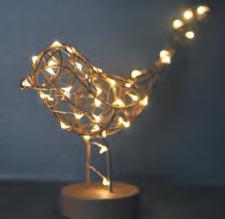

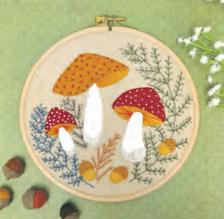


Want to advertise in one of our features? We
Speak
BOSCREGE CARAVAN & TOURING PARK THE MOST PICTURESQUE CARAVAN PARK IN CORNWALL With a welcoming atmosphere and set in 12 acres of Cornish countryside only two miles from the beautiful sandy beaches of Praa Sands, Boscrege Caravan & Touring Park is the best place to enjoy your Cornish holiday. Each of our luxury holiday homes comes with a private garden and Wi-Fi. Perfect for families and couples, we are open all year, and offer seasonal pitches. We offer the following: • Designated dog walking fields • Pet friendly accommodation • Comprehensive storage • Luxury holiday homes for sale 01736 762231 • enquiries@caravanparkcornwall.com www.caravanparkcornwall.com CARAVAN & TOURING PARK LUKESLAND GARDENS Harford Ivybridge PL21 0JF Tel 01752 691749 www.lukesland.co.uk Fine Autumn Colour Pools & Waterfalls Home-made soup & cakes Sundays and Wednesdays 11am - 5pm 2nd October - 13th November Soak up the spectacular colour... at Batsford this autumn. Browse our selection of plants and gifts and treat yourself to a home-baked lunch or afternoon tea in our recently extended café. A perfect day out for all the family – including the dog! BATSFORD ARBORETUM AND GARDEN CENTRE Batsford, Moreton-in-Marsh, Gloucestershire GL56 9AT. Tel: 01386 701441 E: arboretum@batsfordfoundation.co.uk Pre-booking essential at www.batsarb.co.uk BatsfordArboretum@BatsfordA@BatsfordA or Delivered to Your Door 'Wrap Free 'Click & Collect' POST or Delivered to Your Door 'Wrap & Send' Service Buy Online or Visit Our Corfe Castle Shop www. seasonsgreen.co.uk 01929 477 228 Gift Shop & Gallery Corfe Castle to You or Direct to Your Recipient Inspired by Gardens, Coast and Countryside www.countrygardener.co.uk 19
JOBS IN THE October garden
Autumn is officially here, in all its golden glory. The ground is now wet with dew in the mornings and the garden starting to be covered in cobwebs, but some days into October will feel glorious and still warm. The hot dry summer means that leaves are falling early from the trees in abundance and a lot of summer crops came to a premature end.
Preparation for winter is in full swing – fruit and autumn veg are starting to be ready to be brought in and stored, and plants should be cut back, wrapped up or brought inside to help them survive the chilly winter temperatures.
Full of beans
2Sow broad beans now for an early crop next year. On some soils in particular if it has clay in it soil is hit and miss, but it is definitely worth sowing now if you have anything like well-drained soil.
You need hardy varieties such as ‘Aquadulce Claudia’ to make the most of over-wintering.

Mulch that bare soil
Large areas of bare soil start to appear in all parts of the garden. If left over winter, the soil will lose nutrients. Use organic mulches to protect it and give good structure for next year’s growing season. Best mulches are a thick layer of autumn leaves, wetted so that they don’t blow away,straw, grass clippings and autumn leaves mixed together, cutback plants such as sweet peas, peas or runner beans, chopped up sheets of newspaper, covered with damp grass clippings to weigh it all down.
1Still time to plant spring bulbs
You can continue to plant spring bulbs in the still-warm ground, to give them the longest possible growing time ahead of next year. Narcissi can be planted in pots or in borders underplanting dahlias etc or in lawns.
Alliums are best planted while the soil is still a little warm in early-mid Autumn, in contrast to tulips, which benefit from going into the ground when the temperature has dropped (when the diseases and fungus that they are prone to during the warmer months have died off).
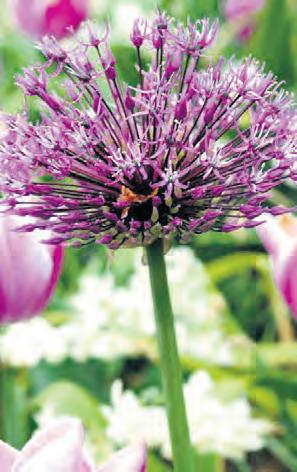
Plant peonies this month as well, and established peony plants should be pruned shortly after the first frost. You can brighten up shady bits of your garden with springflowering, shade-tolerant bulbs. Go for snowdrops for January and February, followed by Anemone blanda ‘White Splendour’ and narcissi for March and April, finishing with bluebells in April and May.
Keep turning the compost heap
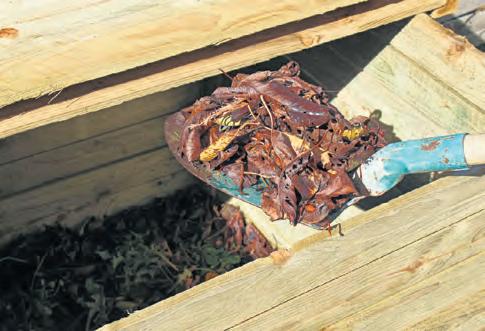
Turning the compost heap is important at this time of year. As the garden is tidied in preparation for winter, lots of material is generated for composting so don’t just load the new material on top of what has been decomposing during the summer. To encourage the whole bed to rot down quickly, turn the contents regularly to stir it up and allow in lots of air. In the colder weather, the rate of decomposition will naturally decrease, but it will soon speed up during warmer spells.
53Get plants ready for Christmas
Prepared hyacinth bulbs can still be planted now. Use bulb fibre or general-purpose compost but don’t be tempted to use ordinary soil which might contain worms. Bulbs should be close but not touching either each other or the sides of the pot. Fill with compost allowing the tips of the bulbs to show. Water, but don’t overwater, and place in a cool dark cellar, garage or somewhere similar. Check regularly, watering a little if necessary. You don’t want them to dry out. Once the shoots are a couple of inches high you can bring the pots indoors.
Give a little time to the wildflowers
Wildflowers only need to be cut down once a year. Wait until they have finished flowering and the seed heads have ripened, adjust the lawnmower wheels onto their highest setting, remove the grass collection box and run the mover over them, or if you fancy a lot of exercise, try a scythe. Leave the cuttings on the ground for a few days to allow any seed heads to dry and for the seeds to fall. Collect up the remaining stems and put them in the compost heap.
Time to revitalise or re-plant rhubarb
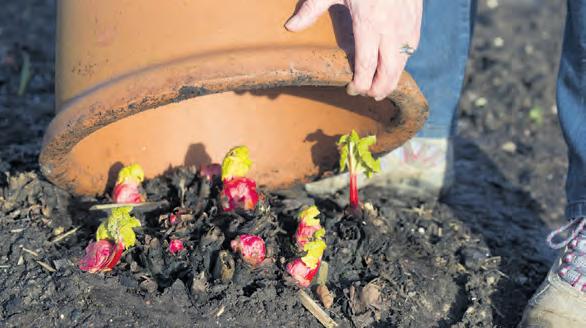
Revitalise your rhubarb. Dig up big old clumps and divide into pieces using a sharp spade, making sure that each division contains a piece of root and a shoot, then discard the old centre. This is also the time to buy and plant new rhubarb crowns.
Plant new crowns any time from now onwards through to the end of November. If the weather is reasonably dry and mild then you can plant through to the end of the year. Buy named cultivars, or choose a division from a strong, healthy-looking plant.
On wetter soils, planting with the buds just raised out of the soil may help prevent rotting of the plant. If planting more than one crown, space plants one metre apart, with one to two metres between rows.
With healthy, organically fed plants you should try for yields of 20 lbs per every three metre row.
For an even earlier harvest, lift some roots in November. Ideally leave the lifted roots outside for up to two weeks prior to potting to expose them to more cold - this is needed to overcome dormancy.
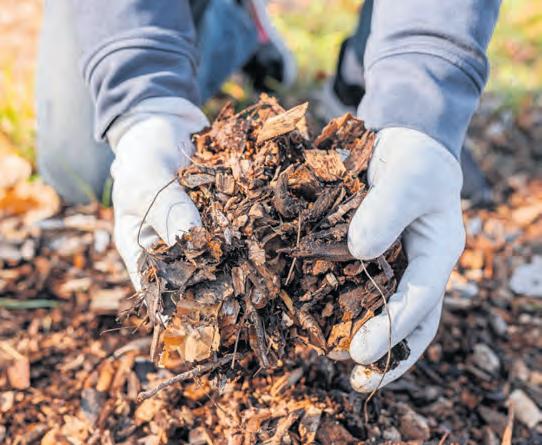
JOBS FOR THE MONTH
4
7
6 Country Gardener20
Cut back perennials that have died down
Perennials are not demanding plants, but trimming them after flowering finishes in autumn helps improve their appearance and flowering. However, you can leave some stems over winter to provide homes and food for wildlife, and then trim back in spring.
Cutting back herbaceous plants during autumn restores order and tidiness to the garden. However, this removes potential winter interest, in the form of height and structure, plus food and habitat sources for wildlife so think about delaying the cut back until spring.
Make the most of your fig tree

If you have a productive fig tree, take cuttings now. They should be about a foot long, this year’s growth, with the softer tip removed. Cut the tip-end at an angle so you know which end is up then insert cuttings into a trench of well-drained soil.
HOW TO GROW SEA HOLLIES
Sea Hollies or as they are known by their botanical name eryngiums are architectural, spiny, almost sculptural perennials, some looking superficially like thistles, but which can make a dramatic statement in a border.
You can let them rise above low-growing plants, or mingle them among roses and taller perennials to provide a contrast in form and texture.
Order garlic and onions
Garlic and overwintering onions are planted out from now till the end of October but get your order in as soon as possible or you will be picking over the spoils. Get used to regularly overwintering onions; try ‘Japanese Shensyu Yellow’, and ‘Radar’ for red onions. Garlic does best planted out as early as you can; ‘Solent Wight’ and ‘Cristo’ are both reliable and hardy. Onions need to be spaced 20cm apart each way; garlic is best at 18cm each way. Choose your sunniest spot.
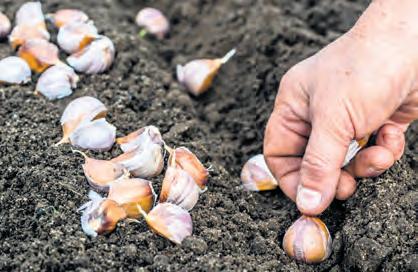
11Be sensible with your lawn
This autumn lawns will need a bit more care. The intense heat of August has left many still recovering and they are much worse off that they normally are at this time of the year.
It’s important to rake your lawn regularly in October if you want to make sure that fallen leaves don’t stop light and air from getting to your grass. Without enough air and sunlight, your lawn will be more prone to disease. You can use fallen leaves to create leaf mould – an invaluable soil conditioner.
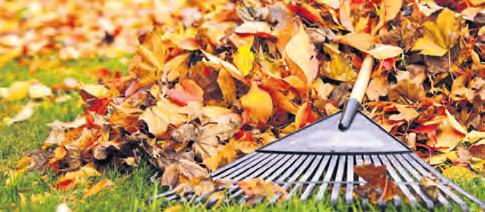
October is also a good time to give your lawn one last trim before frost really starts to take.
Ideally your grass will be about three inches long come the winter – not tall enough that it will invite snow mould (a fungus caused by frost or snow), and not too short that it will go hungry over the winter because it can’t optimise photosynthesis.
Cutting your grass too short could mean that it spends the spring time recovering from shock and trying to repair the damage that was caused over the winter, rather than bouncing back healthy and strong.
Time to get spring cabbage in the ground
It’s not too late to get your spring cabbage plants in the ground. ‘April’, ‘Durham Early’, ‘Offenham 2’, and ‘Spring Hero’ are varieties that you could try. Although they won’t grow much over the winter, they should flourish next spring.
You should space young cabbage plants as far as 18 inches apart, to give them plenty of space to grow.
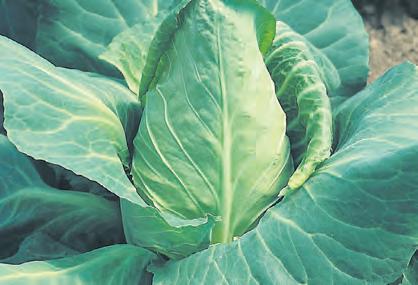
They’ll also need a good amount of water when they’re first planted. Cabbage plants are quite hardy, so they should be perfectly fine during the winter, unless it’s exceptionally cold. In this case, you might find it helpful to use a cloche (a cover) to protect them.
One of the main issues that young cabbage plants face is that they risk damage from pigeons. To counteract this problem, you can stick a couple of feathers into a potato and hang it from a string over your cabbage patch, to ward them off. The pigeons will think that your cabbages are being guarded by another bird, and will usually keep away.
Adaptable pansies
If you want your garden to have a fresh burst of colour during the winter, then consider planting pansies this month. Winter pansies are hardy plants that will often continue to flower throughout the coldest months of the year.

Pansies have an amazing ability to adapt to frosty temperatures and still come out strong in the spring. However, they must be planted at the right time to achieve this (when the soil is between seven to 21°C). After flowers have bloomed and began to wither, they should be pinched off to encourage new flowers to continue growing.
Upright, branching stems bear greenish-white or blue flowers gathered into a cone surrounded by a ruff of spiny bracts. In some, the upper part of the plant is suffused with metallic blue.
The thistle-like flowers are made up of tiny flowers packed together in a tight cluster. With colours ranging from grey to intense cobalt blue, eryngiums are striking plants. There are over 250 species and lots of garden cultivars to choose from. They look wonderful in gravel gardens or mixed herbaceous borders and they’re good for attracting pollinating insects.
Eryngiums make good winter silhouettes and the flowerheads are great for cutting and using in fresh and dried arrangements.
Eryngiums need plenty of sunshine and free-draining soil. They can tolerate poor soil, and a spot at the foot of a wall is a good position as the soil will remain dry over winter. It’s also a good idea to plant eryngiums away from the edge of a border or path, as their spikes can be quite sharp. They work well in gravel gardens and don’t need a lot of watering.
Species eryngiums can be grown from seed, although if you have a named cultivar, take root cuttings to ensure it stays true to type.
• ‘Neptune’s Gold’ – a colourful plant. The spiky bracts are silvery blue at the base, turning gold at the tips.
• ‘Big Blue’ – as the name suggests, the flower cones are large and a very intense blue. They appear from June to August and contrast beautifully with the grey-green in leaves.
• Sea hollies die down completely in winter and, given good drainage, will return every year.

• Deadheading should be part of your sea holly plant care. Pinch or cut off spent flowers to encourage additional blooming.

• Sea Holly is self-sowing but non-invasive. If it crops up in an area where you don’t want it, it is easy to remove.
• Holly plants are toxic to cats, dogs and horses because of the “saponins” found in the plant roots. Clinical Signs of Illness may include: vomiting, diarrhoea and depression. Leaves and berries found on the holly plant are low in toxicity.
9 12
8
10 13
21www.countrygardener.co.uk
country gardener CROSSWORD
WIN £100 IN RHS GIFT TOKENS
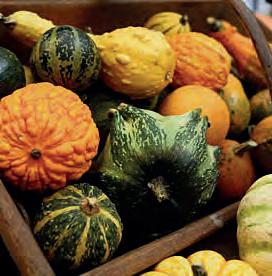


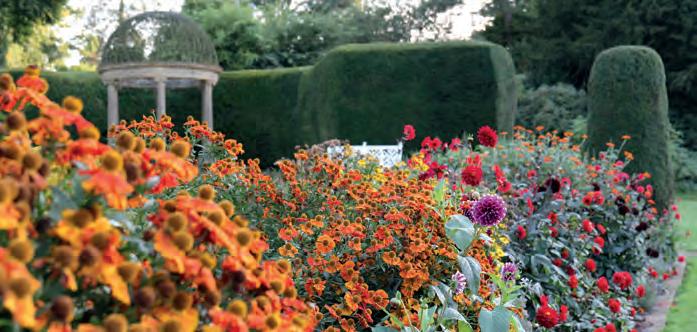

Welcome back to our popular gardening themed crossword compiled by Saranda which over the past year has become enormously popular with readers. The winning entry to be drawn by us will receive £100 of RHS gift tokens. Completed entries should be sent to Mount House, Halse, Taunton, Somerset TA4 3AD. The closing date for entries is Friday, 28th October. The winner of the September issue crossword was Jonathan Howard from Chippenham.
ACROSS
1. A plant without flowers? (9)
6. Soothing infusion prepared from a garden flower (8,3)

12. Scottish actor (1900-76) famous for playing Scrooge (8,3)
13. A juicy fruit like a peach (9)
14. Large freshwater lake in the Sierra Nevada mountains (5)
15. 1945 Pacific battle won by the United States (3,4)
16. Coarse parts of flax and hemp (7)
18. Ecclesiastical name for ground elder? (6)
19. Declares (6)
20. Scottish river (5)
23. Line of trees or shrubs planted to protect a field of crops (11)
25. Alternative name of Polaris (5,4)


27. Euphorbia marginata, an American spurge (4-2-3-8)
31. Where W. B. Yeats had nine bean rows? (9)
33. Resembling a tree in growth or appearance (11)
34. Cawdor Castle’s famous gardens are five miles from this town (5)
lemon balm (7)
Any plant of the genus Helianthemum (3,4)
snapdragons (11)
minutina (5,4)

family with pink flowers (6,4)
2. Any plants of the genus Atriplex (7)
3. Plant from Madagascar also called devil’s backbone (6,2,9)
4. Genus of plants in the sunflower family known as tasselflower (6)
5. East Indian tree whose leaves are used for fodder (6)
6. Horticultural poem by Tennyson? (4,4,3,6,4)
7. New York borough and heart of the Big Apple (9)
8. Portuguese monkeys or lemurs (7)
9. Open area of grassy land (3)
10. Name given to alliance between the UK, France and the Russian Empire (6,7)



11. Common plant found on waste ground, Smyrnium olusatrum (10)
17. Dicentra cucullaria, a native North American plant (9,8)
21. Leafy glade or bower shaded by trees (6)
22. A reddish-purple root vegetable (4)
24. Compounds extracted from plants to capture their scent and flavour (9,4)

26. Of a river, cease to flow or have any water (3,3)
28. Massive tree native to the Pampa of South America (4)
29. Mentioned by Shakespeare in Macbeth, once a great forest (6,4)
30. A person who doubles for an actress in dangerous scenes (10)
32. Horsetail belongs to this genus (9)
35. Short-lived perennial also called sea lavender (7)
37. A cherry pepper or allspice (7)
38. An above-ground spa? (3,3)
39. Of or relating to iron (6)

44. Surname of South African golfer ‘The Big Easy’ (3)

35. Short and fat like a potato (6) 36. Rascal or rogue (6) 40. Genus of the common garden plant
41.
42. To cook up or cage (obsolete) (5) 43. Person believing in the ideas of Alexandrian biblical scholar Origen (9) 45. Genus of plants commonly known as
46. Deprecated or disapproved (11) 47. This plantain is sometimes called
DOWN 1. Chinese shrub of the honeysuckle
CROSSWORD 1 2 3 4 5 6 7 8 9 10 11 12 13 14 15 16 17 18 19 20 21 22 23 24 25 26 27 28 29 30 31 32 33 34 35 36 37 38 39 40 41 42 43 44 45 46 47 Answers from September 2022 on p26 22 Everyone needs a pair of It is that time of year when you need to start looking for gift ideas. Look no further, Backdoorshoes have the perfect solution! They are lightweight, waterproof and durable, ideal for slipping off/on when you need to. Mens and Ladies range available online in sizes UK 3-14. We also have a range of Chelsea ‘Jumpy’ Boots and Wellingtons. Footwear for everyone - we’ve covered all of the weather eventualities! To see our full range visit www.backdoorshoes.co.uk or talk to us on 01202 232357 Our gardens are ablaze with glorious Autumn colour Find your perfect garden: ngs.org.uk/autumn BRITISH AFFILIATED GURKHA NURSES OFFERING SPECIALIST CARE FOR YOUR LOVED ONES Dedicated one to one LIVE-IN care from our team of Nepalese nurses. Tel: 01252 282110 Email: care@poseidon-gp.com Website: www.poseidoncare.co.uk Autuum colourIN ABUNDANCE For the latest garden news, events & advice - don't miss COUNTRY GARDENER Concrete Post Fixings (Wire Anchors) & Easy Trellising System Quick & Easy Solution to fix wires to concrete posts NO DRILLING - simply clamp the two halves together Three sizes to fit most concrete posts FREE UK DELIVERY Main Stockists of Gripple Trellising Visit our website to view our other gardening accessories and gift ideas www.rivelinglenproducts.co.uk info@rivelinglenproducts.co.uk 01246 462666 Wire Anchor Wire Anchor with Gripple Trellising System
Garden advice October
Can any plant live in a room with big heat fluctuations?
How do I get good results if I switch to peat free compost? I want to switch over completely but am a bit concerned if it will be the same growing conditions.


Andy Eason Dartmouth
It’s true that some peat free bagged products can vary in quality and be coarse in terms of texture. It is worth shopping around to find the brand you are happy with. The thing to remember is there are many kinds of peat free compost so be specific about your needs.
Peat-free composts are typically made up from materials such as wood fibre, composted bark, coir and, to a lesser extent, composted garden waste. However, you can also find composts containing sterilised soil, vermiculite, perlite, grit and manure. There is even one series of composts made from composted bracken and sheep’s wool. It’s likely new materials will be have to be used to fill the gap left by the peat ban.
Getting used to peat-free composts when you have used peat for many years can seem daunting, but with a little care you should get very good results. For the past three years Which? Gardening has only used peat-free compost for all its growing needs and knows it’s entirely possible to grow a wide range of plants without peat.
Can you suggest tall trees to grow in pots as a barrier?
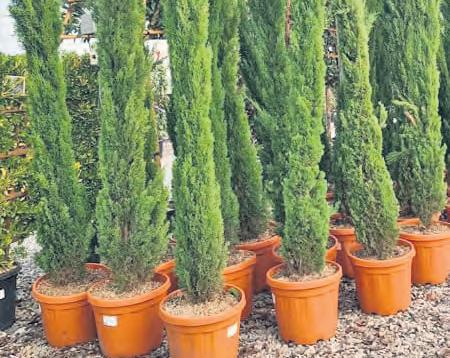
Allan Thornton Sidmouth
Plenty of trees can be grown in pots and containers, providing you with all the benefits of a tree but with the convenience and ease of growing in a pot. Flowering dogwood adds architectural interest with long lasting pink bracts in spring and autumn. Italian cypress (Cupressus sempervirens) grows very tall but can be clipped to keep it in check. Japanese maple (Acer palmatum) are among the best trees for small gardens and are slow growing but will form an attractive clipped barrier.
Should I cut off the suckers on my roses? This summer my roses have produced more than normal.
Kelly Dawson Devizes
Suckers are rapid growths that spring out of the hardy rootstock of grafted rose bushes, just below the grafted knuckle union. Sucker canes will, if left to grow, suck most nutrients necessary for good growth and performance from their grafted counterparts, weakening the upper part of the bush – many times to the point that the upper portion dies. Therefore, removing rose suckers as they sprout is important. Sucker canes will usually take on a totally different growth habit from the rest of the rose bush. They will grow tall and a bit wild, much like an untrained climbing rose. The leaves on the sucker canes will differ from the leaf structure and sometimes vary a bit in coloration too, with few to no leaves. Rose bush suckers typically will not set buds or bloom, at least in the first year of their growth. If a sucker cane is suspected, take a closer look at it and follow the cane down to the base of the plant. Grafted roses will have a bit of a knuckle at the grafted union. If the cane is growing out of the top part of that knuckle union, it is likely the desired rose bush. If the cane is coming from below ground and underneath the knuckle union, however, it is most likely a true sucker cane and needs to be removed.
Anna Greenhaugh Exeter
You could try the wonderful and slow growing Agave parryi which has a clump-forming habit and which can tolerate a dramatic change in temperatures. While it rarely flowers, when blooms do arise, they do so majestically ten to 15 years after planting upon six to 20-foot tall stalks. Summer buds are typically red and open to blooms ranging from gold to light yellow to green.

My dahlias have just not flowered this summer and it has been a mystery. I certainly haven’t done anything different, and it has been so disappointing.
Amy Turner Liss
Unlike other plants, dahlias fail to bloom as a result of only a few factors. One is bloom competition. The problem with being a heavy bloomer is that there are only so many resources to go around and often a plant will put on intense amounts of greenery and then not flower. When your dahlias aren’t getting enough water, they can also stop blooming.
Dahlias love the sun and require at least six hours of full sun each day. If an area has become shady and lacking light it can dramatically affect the way the plant produces blooms. Finally,excess of nitrogen can cause dahlias to stop flowering. Nitrogen is great for leaves and stems but does nothing for blooming, so if you’re seeing lush growth but few or no buds, this may well be the culprit.
Is there a secret to growing celeriac? I would like to grow it and tried some plug plants I bought from the local garden centre but they just didn’t take off?
Cathy Latimer Exmouth
Celeriac isn’t the easiest thing to grow successfully and many gardeners deal with it in the same breath as celery - possible but hard work! Celeriac is best when it comes to harvest in cool weather. It is b est started indoors and later transplanted into the garden.
Celeriac is a shallow rooted plant so make sure you water in dry spells. The plants will also benefit from a top dressing of seaweed / poultry manure pellets during the summer.
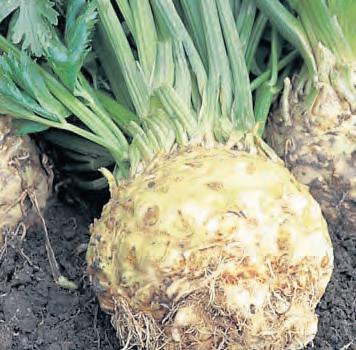
Remove the outer leaves to expose the crown and encourage the bulb to develop. Be careful when hoeing around the plant as the shallow roots are easily damaged. It is important to keep the plants weed free so don’t use that as an excuse! Celeriac requires 90 to 120 days to reach harvest.
We want to plant a new apple tree and only have room for one - will our neighbours’ trees work as pollinators? They are about 20 metres away and the other side of a high fence?
Donna Spencer Exeter
For successful pollination, most apple trees need another one nearby that flowers at roughly the same time. They should roughly be in sight of each other and the distance you mention shouldn’t be a problem- neither should the fence. When choosing a variety, it will certainly help if you know your neighbours varieties, if they crop well then those varieties should do well for you. Plant the trees in sight but not too close as older trees carry pests and diseases and cause root competition if too close.
More questions and queries from our ever-bustling postbag of problems from Country Gardener readers. If you need advice on any gardening problem or concern then write to us at Country Gardener, Mount House, Halse, Taunton TA4 3AD or email editorial@countrygardener.co.uk
YOUR QUESTIONS ANSWERED
www.countrygardener.co.uk 23
Why do my walnuts and hazelnuts not produce any fruit? We look forward to the crop every year but this year something has happened.
Pam Burns Portsmouth
Walnuts can be both late and troublesome and they will not produce fruit in cold sites. The male flowers can also miss the femails on the same tree so often you need everything to go just right to get a decent crop. You can hand pollinate on a smaller tree. Hazelnuts should be better. They are partly self-fertile. Perhaps your site has been too dry which is very understandable this summer. Spread wood ash around the base as this often helps.
Is it of any value to grind up eggshells and use them in the garden?
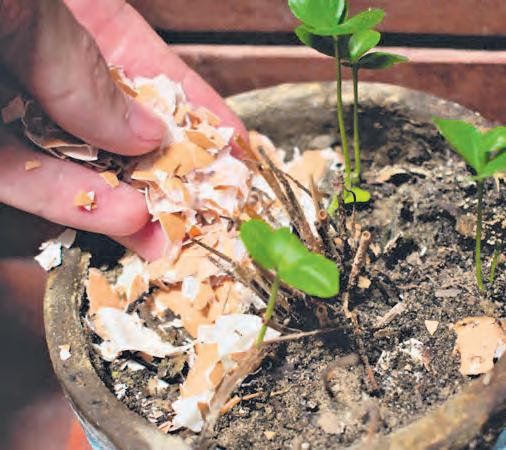
Eggshells contain calcium, a mineral which it is true is very important for the health of plants. It depends on the size of your garden. If it is a medium or large garden then it may just not be worth it since most gardens in this country are very rarely deficient of calcium in the first place and it will be a lot of trouble for not a lot of benefit.
I am busy planting a whole area of the garden with daffodils bulbs but I am worried that so many failed to flower this year. Is it weather conditions which are likely to be the problem?
 Maggie Allison Martock
Maggie Allison Martock
Daffodils are usually very reliable so any that didn’t open might as you suggest be an issue with the weather. They are simple and normally trouble free bulbs. Excessive wetness for instance can cause a fungal infection during the winter and if this is the case there is little you can do. The leaves will appear but there is no goodness to produce the flower. Avoid ground which you know gets excessively wet. The opposite weather conditions also cause problems drought during the flowering period. So, if there is a long dry spell next spring try some extras watering
My garden has been plagued by squirrels this summer
Pam Dickens Taunton
There aren’t many options when it comes to deterring squirrels and they are both a damaging and difficult pest to deal with. The solutions tend to be a bit drastic if they are regular visitors to your plots. You can protect everything with extensive cover that the squirrels cannot get under so buy a roll of galvanised chicken nettings and cut and bend into long half cyclinders and place over especially young crops.
Is an avocado a good idea for growing indoors? I always stop and think if I could grow one?
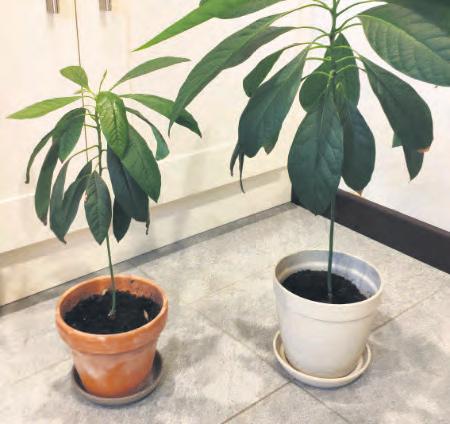
India Palmer Plymouth Avocados have a reasonable success as indoor plants and can be straight forward to get going but their scope is rather limited. They can flower and fruit inside but it is rare and mostly do not crop. That doesn’t mean they cannot be enjoyed as a leafy ornamental plant, better to enjoy them as an ornamental houseplant.
Cutting to the quick
Country Gardener reader Raymond Butler from Exmoor sings the praises of being able to use a scythe properly, carefully and quietly to cut his grass
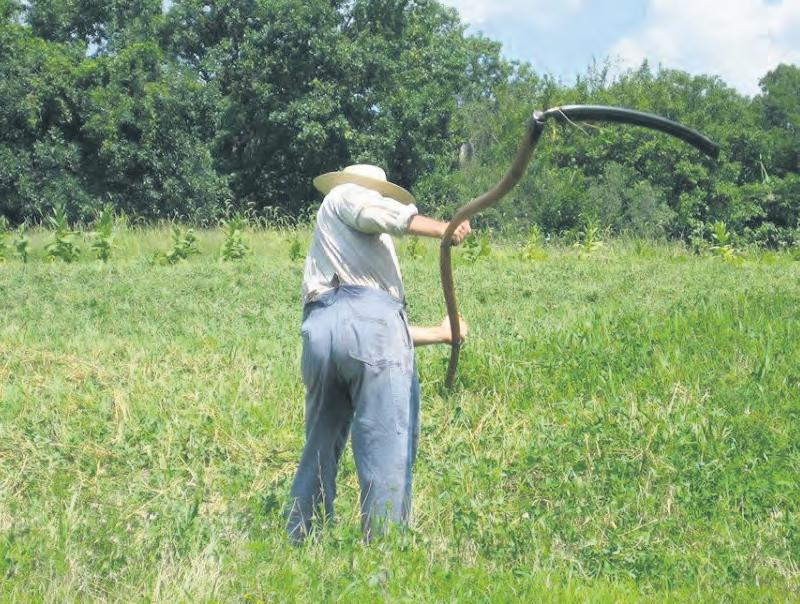
Scything is all about timing, rhythm and momentum
I have just come in from mowing the lawn. I left it long and wild during the heatwave but now it is white rather than green and very uneven.

This isn’t maybe worthy of a letter to Country Gardener but I hope it is when you realise I cut it with a scythe. Two years ago, I had a day course in Dorset which was both illuminating and in its own way thrilling. Scything for me is now a way of life in the garden and I would encourage others. Many people mow their lawn with a scythe.
Yes, it’s hard work and to start with the lawn isn’t going to be a bowling green. But there are other benefits.
Besides a sharp edge, mowing when the grass is wet helps. It is not necessary for the grass to be wet, but it does improve the cutting. The moisture adds weight to the short grass helping it stand up as the scythe slices through it. The moisture lubricates the blade and softens the grass so it is easier to cut.
Short grass can be difficult to mow. It hasn’t the weight and inertia of taller grass. Once the blade has hit the grass a couple of times the grass seems to turn to rubber, bending over and springing back up after the blade has passed.
Absolutely, a scythe blade needs to be razor sharp at all times, and would be given a few seconds of sharpening every five minutes or so during use to keep it this way. It is badly set or maintained lawnmowers that produce split ends in lawns. Most domestic lawn mowers and strimmers are rarely, if ever, sharpened; they rely on brute rotary speed to sever grass blades. The bruising from these blunt instruments can cause unsightly straw-coloured die-back at the tips of grass leaves.
Scythes have been developed and refined over their almost 2,000 year history into a remarkably ergonomic tool. Properly set up and used they are good exercise for all parts of the body, including the back and core muscles.
MY TIPS:
• A long blade is not necessary. Short blades work well and may be easier to use. It takes longer to mow the lawn but short blades don’t have the extra weight and resistance of longer blades.
• Don’t expect the finished lawn to look as neat as if it were done with a rotary mower, especially the first few go-arounds. Give yourself time to develop the skill of close cropping a lawn.
• Expect scything a lawn to take longer than with a power mower.
• Your neighbours will appreciate your quiet, motorless mower.
• A scythe will mow wet and/or thick grass that would bog down and stall a power rotary or hand reel mower.
• Slice with the blade, do not hack; you are not teeing off in a golf game.
• Light, gentle strokes are most effective. Mowing is a shearing action. It’s more like slicing a tomato than splitting wood.

READERS STORY
24
Ireley Hardy Plant Nursery

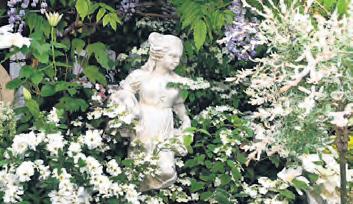
March to November,

Broadway Road, Winchcombe, Cheltenham, Glos, GL54
Tel: 01242 604160 Web: www.ireleynursery.co.uk Email: ireley_nursery@hotmail.com


The Wild Side
Gardening with wildlife in mind
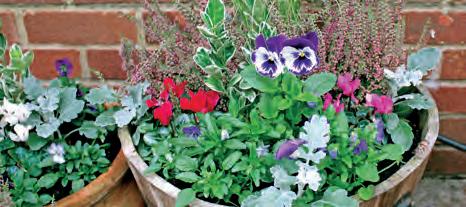
Practical, beautiful gardens that provide habitat for wildlife.
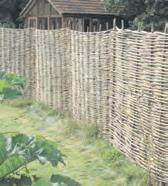
Whether it’s a new planting scheme or a full scale re-design of your garden, please get in touch.
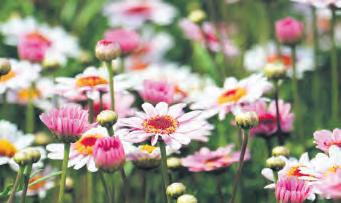

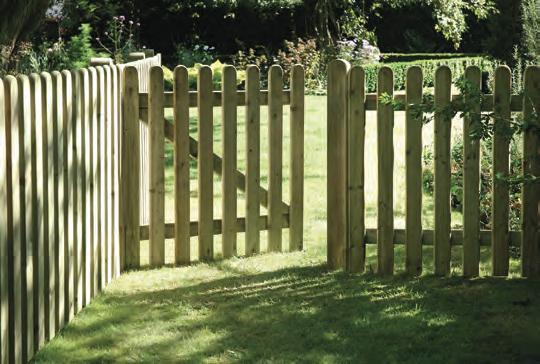
www.wild-side.org






EMAIL: rebecca@wild-side.org TEL: 01989 565380 07908011934

Covering Herefordshire, Gloucestershire and Monmouthshire. Outside these areas will also be considered.
Garolla garage doors are expertly made to measure in our own UK factories, they’re strong and solidly built. The electric Garolla door rolls up vertically, taking up only 8 inches inside your garage, maximising valuable space. Our expert local installers will fit your new door and they’ll take away the old one too, so there’s no mess.

www.countrygardener.co.uk 25 OPEN 6 DAYS A WEEK: Summer 9am - 5.30pm, Winter 9am to Dusk, Closed on Sundays. Guarlford - Malvern - WR13 6NT 01684 562544 grangefmnursery@btconnect.com Beautiful plants to create your own unique garden Specialist Plant Centre Grange Farm NURSERY TIMBER MERCHANTS AND FENCING SPECIALISTS Open: Mon-Fri 8am-5pm Visit our well-stocked yard for timber, gates, fencing, decking, trellis, pergolas and arches, plus expert advice. TRY OUR ONLINE FENCING CALCULATOR AT www.hartwellfencing.co.uk 01386 840373 The Timber Yard, Weston Subedge, Nr Chipping Campden, GL55 6QH *Offer valid for openings up to 2.4m wide & including 2 remote controls, 55mm white slats, internal manual override.
Give us a call today and we’ll come and measure up completely FREE of charge. From £895 for a fully fitted electric garage door. Gotta get a Garolla. WHAT’S INCLUDED WITH EVERY DOOR: • EXPERT MEASURING & FITTING • 2 REMOTE CONTROLS • ACOUSTIC & THERMAL INSULATION • FREE DISPOSAL OF YOUR OLD DOOR • AVAILABLE IN 21 COLOURS CALL US TODAY ON: 0800 135 7065 MOBILE: 07537 149 128 Tel: 01666 822171 www.foxleyroadnurseries.co.uk Foxley Road, Malmesbury, SN16 0JQ Plants & Bulbs for Autumn Containers Orders Taken ~ Local Delivery FOXLEY ROAD NURSERIES OPEN 7 DAYS A WEEK Coventry Road, Guy's Cliffe, Warwick CV34 5FJ 01926 492273 info@hintonsnursery.co.uk Hintons is a not for profit organisation Delivery service available National Garden Gift Vouchers www.hintonsnursery.co.uk New FRUIT TREES in stock WINTER BEDDING and HANGING BASKETS now available Great range of nursery grown plants & EXCELLENT SELECTION of gardening SUNDRIES & COMPOSTS, EXPERT ADVICE & PLANTING PLAN SERVICE
Cottage Garden Plants including Shrubs, Climbers, Hardy Perennials, Herbs We stock a small range of ornamental trees and specimen shrubs Most of our plants are propagated/grown in the Nursery Open:
Tuesday to Saturday, 2pm to 5pm Other times by appointment
5NY
The perfect red rich rowan tree
Most mountain ash species and varieties aren’t too fussy about their position – they will grow in open, sunny sites or partial shade. They prefer a fertile, well-drained soil enriched with lots of organic matter, which holds plenty of moisture in spring and summer, doesn’t dry out or become waterlogged.
VEGETABLES TO PLANT THIS AUTUMN
Whoever said there’s never a gap in the gardening season was certainly correct when it comes to the autumn as there are plenty of vegetables which can be planted.
Garlic
Plant bulbs two cms down into compost improved, well-drained soil in full sun. Cover with fleece if necessary, as this time of the year they are an attraction for birds and especially pigeons. Varieties -try Elephant Garlic or ‘Provence Wight’.
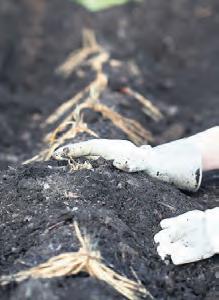
Perpetual spinach
Sorbus, often called mountain ash or rowans, are attractive, deciduous, ornamental trees, many of which are suitable for even small to average-sized gardens.
If you are looking to add a tree to your garden this autumn this is the perfect choice.
They look fabulous in spring, covered in their flowers, and again in autumn when their fruit and autumn foliage provide more interest and colour.
In Britain,the rowan has a long and still popular history in folklore as a tree which protects against witchcraft and enchantment.
Bane of witches, diviner of the future and producer of jam, rowan is an elegant tree with a mystical history. Its leaves and berries are a favourite for wildlife in woods and towns alike.
They have a very distinct smell that attracts flies, beetles and bees.
Mature trees can grow to 15 metres in height and can live for up to 200 years. The bark is smooth and silvery grey, and leaf buds are purple and hairy. Look out for its five to eight pairs of serrated leaflets which are distinctive.
Ideally you can plant bare-root trees from October onwards and certainly between November and March, and pot-grown trees any time of year unless the soil is frozen.
Dig a square hole and remove weed roots. Fork the soil to make it pliable. Place the tree in the planting hole and check its depth – ensure it sits at the same level it was in the ground or in its pot, for bare-root plants look for the ‘soil tide mark’ towards the base of the stem. Once you’re satisfied with the depth, fill around the roots with soil until the hole is filled, and firm gently. Water well.
Add a tree stake to prevent root rock, this will need to be in pace for around two years.
Rowans need very little attention after they’ve become established. Water in very dry weather and mulch annually with well-rotted horse manure or compost. You may need to cut back suckering shoots coming from the base of the tree. Prune out dead or damage stems from late autumn to spring.
• Sorbus aucuparia, the common mountain ash, is an upright tree with clusters of white flowers in late spring, followed by orange-red berries in autumn and yellow autumn leaf colours.
• Sorbus cashmiriana can be grown as a large, spreading shrub or small tree. The pink flowers are followed by white fruit in autumn.
• Sorbus commixta ‘Embley’ is an upright, mediumsized tree with creamy-white flowers, deep red fruit and bright red and orange autumn leaf colours.
What does a rowan tree symbolise?
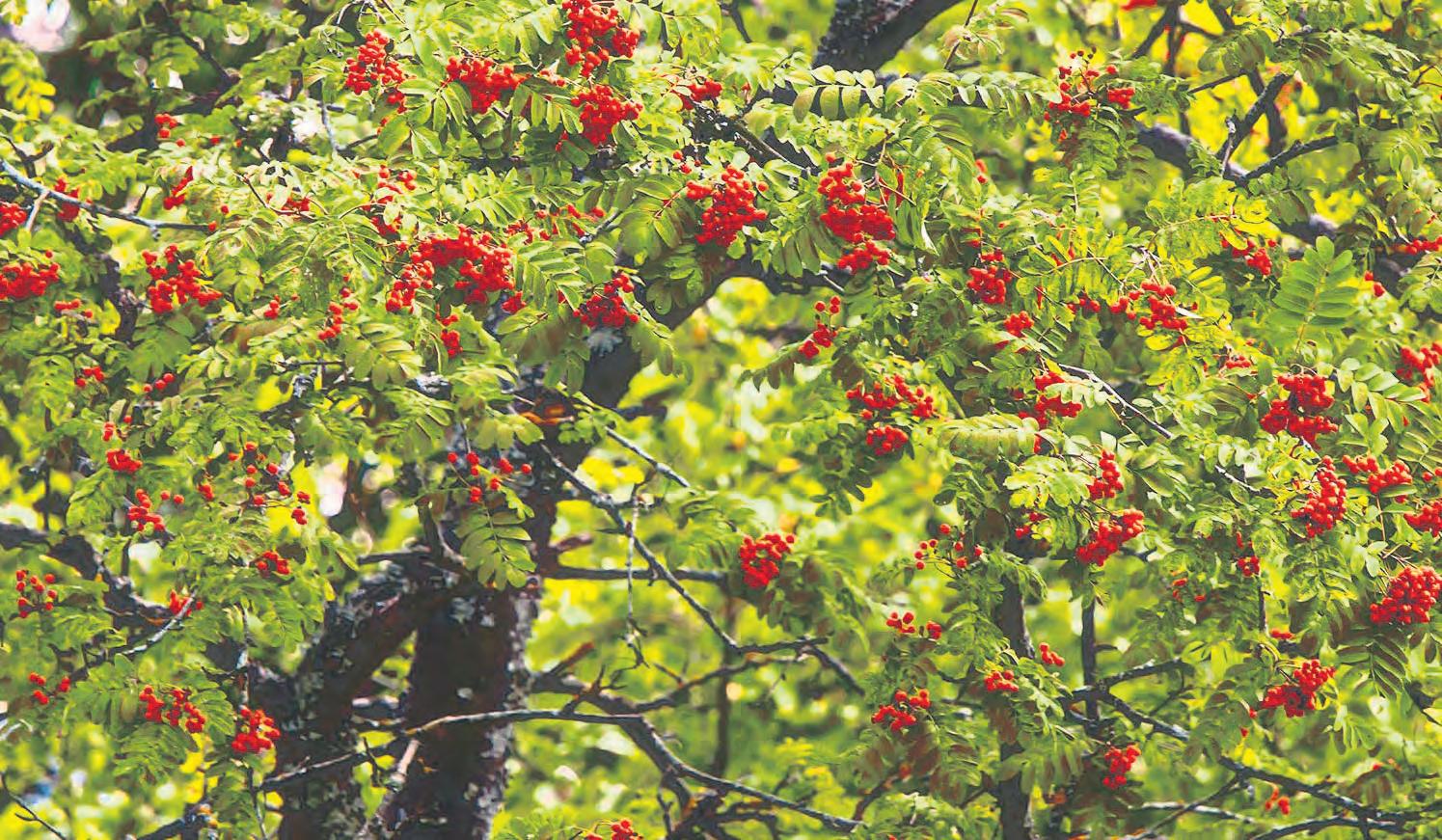
The rowan tree and mythology
• Since ancient times people have been planting a rowan beside their home as in Celtic mythology it is known as the ‘Tree of Life’ and symbolises courage, wisdom and protection.
• The tree features heavily in witchcraft mythology, with people all over the world planting them outside their homes to ward off evil spirits, witchcraft and the undead. In Wales, they were planted in the grounds of cemeteries, and to cut one down was forbidden.
• The rowan features in Norse mythology and legend has it that it saved the life of the god Thor by bending over a fast flowing river in the Underworld in which he was being swept away. Thor managed to grab the tree and get back to the shore.
• The rowan has a long and still popular history as a tree which protects against witchcraft and enchantment. The physical characteristics of the tree may have contributed to its protective reputationeach berry has tiny five pointed star or pentagram opposite its stalk. The pentagram is an ancient protective symbol.
• People also believe the colour red was the best protection against magic.
A hardy cut and come again crop for winter, you can sow continuously for long term crops into next year. Keep harvesting fresh young leaves. Stagger sowings every week for the next month for larger yields.
Asparagus
Plant in well drained, manured soil in a 20 cm trench with a mound at the centre and plant each crown at the top of the mound. Try ‘Mondeo’ or ‘Majestic’ both suitable for autumn planting.
Broad beans
Autumn sowings of broad beans will give you an early start for next spring and a head start for eating from the vegetable plot. Weed regularly and stage as necessary. The more growth they put on in autumn the earlier the crop will be next spring. ‘Aquadulce Cllaudia’ is a hardy popular variety.
Spring onions
Sow thinly and keep the soil moist. Harvest little and often and pick when pencil thin plants come through. This way there’s no need to thin out. ’White Lisbon’ is a variety worth trying.
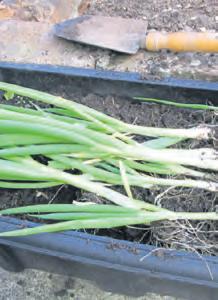
Sorbus is steeped in history and its bright berries and leaves make it a classic choice for the autumn garden and now much in demand
Rowan trees - steeped in tradition and mythology B T L C H S A B A L R E S I N A T E D L R S N C L V B L U E B O T T L E I L E X E L I L C A R O S E O F S H A R O N I O M K N B V I N B L O O M O D O U R E D A A N N P S R A R I S T O L O C H I A C P S D P T S H E A E N D O P L E U R A A N A I Y T I G R E E N L U N G D O N N E D L G N E Crossword answers from September 2022 issue: Country Gardener26
HOW TO BUY AND USE COIR

Coir is an exciting alternative growing medium for plants of all descriptions which is capturing the attention of gardeners.
Natural, biodegradable, and peat-free, CoirProducts.co.uk provides an innovative range of coir-based products. With the largest portfolio of coir product varieties in the UK, all the products are ethically produced and sourced, with minimal harm on the environment.



Coir has excellent water retention ability, air porosity, and drainage, which help plants develop strong and healthy root systems.
Easy to use, they are ideal for growing a variety of plants and crops, indoors and outdoors.



One of the most popular products is coir potting mix, available in various sizes of blocks, bricks, and discs, depending on your need. To use, add enough water and watch it expand (the amount of water added would depend on the size) Once expanded, stir and fluff the coir, and place the potting mix either in a coir pot or on the ground. As a guide, if using the 5kg coir potting mix (block), add 18-20L of water, and once expanded, you will get over 70L of coir.
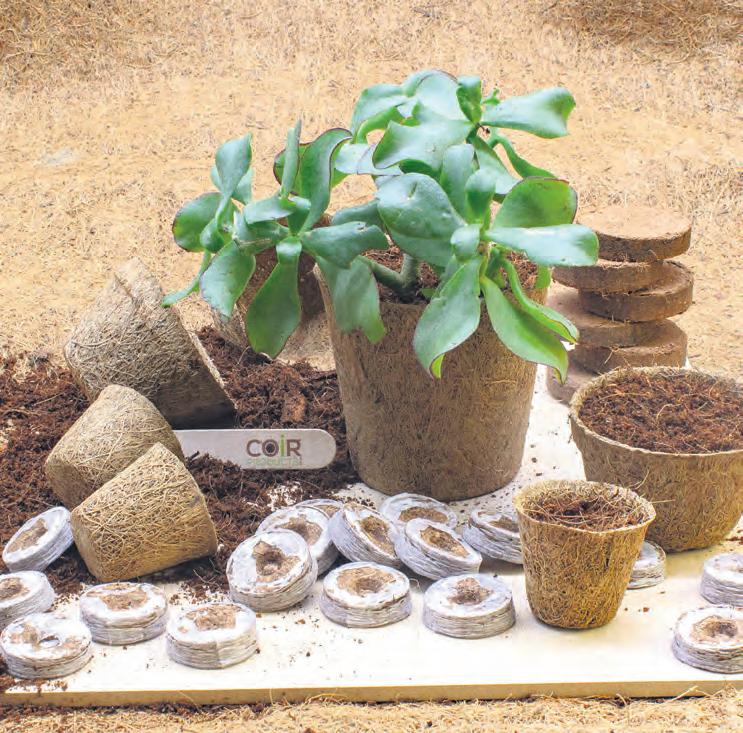
Coir pots come in sizes ranging from five cm to 35cm. If you are looking to grow flowers and vegetables in pots, the larger pots are suitable for crops such as tomatoes, carrots, broad beans, beetroot, while the smaller-sized pots are ideal for sowing herbs and chillies.
Unlike plastic pots, coir pots allow plant roots to grow through the coir, and there is also no transplanting shock when repotting. As plants grow, you can simply relocate the plant with the pot itself on the ground, where the pot will start to disintegrate, giving roots further room to grow. CoirProducts.co.uk also provides coir hanging baskets that are great space savers. They are ideal for growing crops such as strawberries.
For sowing, CoirCoins are known for their high germination rates. The cover of the CoirProducts.co.uk CoirCoins that holds the coir together is biodegradable. Coming in four distinct sizes, just add water to use the CoirCoins and the coir will expand into the biodegradable cover. CoirCoins allow plant roots to grow through them, thus allowing plants to thrive.
In addition, if growing creepers, grow poles provide the perfect support. CoirProducts.co.uk growbags have been used widely for growing tomatoes, strawberries, orchids, and roses, among others. Coir chips are an ideal soil conditioning supplement. CoirProducts.co.uk also offers a unique select of coir bundles, including for kids.
All products can be purchased via the online shop www.coirproducts.co.uk/shop and delivery is free within mainland UK. For the eco-conscious grower, CoirProducts.co.uk has also taken steps in offsetting the carbon footprint in transporting goods to the UK.
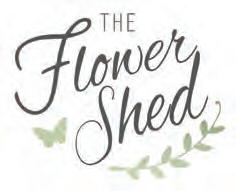
This new growing material is extracted from the tissues surrounding the seed of the coconut palm and is becoming a favourite with gardeners
www.countrygardener.co.uk 27 MAKE THE MOST OF A utumn 2022 FREE & AMPLE PARKING Creating beautiful flowers for all occasions PLUS chocolates, wine, gifts and balloons FREE LOCAL DELIVERIES (WITHIN A 4-MILE RADIUS) Mythe. A38 Worcester Rd, Tewkesbury GL20 6EB EMAIL: flowers@flowershedtewkesbury.co.uk Family-owned and managed “independent” Garden Centre, catering for all your gardening needs and so much more. Stockist of a wide range of well-known gardening brands and locally sourced plants, trees and shrubs. Browns Garden Restaurant serving Breakfasts, Homecooked ‘Fresh’ lunches, Afternoon teas, cakes & treats. SUNDAY ROASTS - BOOKING ADVISED FULLY LICENSED 01684 299996 info@brownsgardenrestaurant.co.uk Open Mon -Sat 9am-5.30pm, Sun 10am-4pm CHILDREN’S PLAY AREA ORDER ONLINE OR CALL US: www.flowershedtewkesbury.co.uk 01684 290288 T: 01684 293103 W: www.tewkesburygardencentre.com Find us on Facebook & Instagram Worcester Road, Tewkesbury, Glos, GL20 6EB OPEN: Mon-Sat 9am - 5.30pm, Sun 10am - 4pm NEW ONLINE SHOP!
Churchwood Valley
running
Wembury Bay
Penrice Castle Gower
holiday cottages on an

century Estate on the Gower Peninsula with beautiful Grade I listed historic park and gardens. Tel: 01792 391212

GARDEN PLANTS/ACCESSORIES


Carmarthen Bay South Wales
Seafront chalet situated on estuary. Sleeps up to 6. Seaview. Well Behaved Dogs Welcome. Free WIFI. Open from 1st March - 31st Dec. For Brochure

Tel: 01269 862191
GLORIOUS NORTH DEVON. Only 9 cosy caravans on peaceful farm. Wonderful walks in woods & meadows. Easy reach sea, moors & lovely days out. £125-395pw. Discount couples. Nice pets welcome. 01769 540366 www.snapdown.co.uk


CORNWALL, NEAR ST JUST. Chalet open all year, sleeps 2/4. Nearby gardens, coast, golfing. Prices from £350pw. 01736 788718
BOSWORLAS NEAR SENNEN/ST JUST, CORNWALL. Cosy Cottage, rural views, Sleeps 2-4 01736 788709 www.bosworlas.co.uk
ACCOMMODATION HOLIDAY COTTAGES

WYE VALLEY/FOREST OF DEAN. Fully equipped 4-star single storey cottage. Two bedrooms both en-suite. Central heating/bedlinen provided. Rural retreat with shops/pubs one mile. Short breaks available. Warm welcome. Tel: 01594 833259 www.cowshedcottage.co.uk
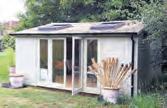
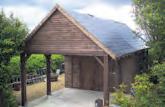
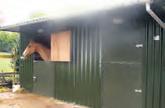

Near Stratford-upon-Avon
Lovely self-catering cottage in peaceful location: large garden. Sleeps 2. Perfect for famous gardens, NT properties & Cotswolds.
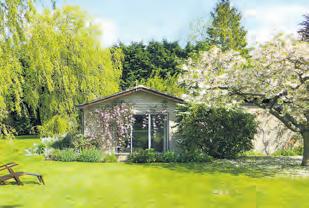
Tel: 01789 740360
www.romanacres.com
NORTH DEVON NEAR CLOVELLY. 3 delightful cottages situated in 12 acres of idyllic countryside. Sleeps 2-4. 1 Wheelchair friendly. Prices from £190p.w. Brochure: 01237 431324 www.foxwoodlodge.co.uk foxwoodlodge@outlook.com
CARDS & PRINTS
GARDEN SERVICES
A range of over 200 greetings cards and prints from the flower paintings of ANNE COTTERILL

We sell to both individuals and trade. No order too small. Contact us for your free catalogue.


Mill House Fine Art Publishing, Bellflower Gallery, Market Place, Colyton, Devon EX24
PERSONAL
POSTAL FRIENDSHIP CLUB. Friends, pen pals, perhaps romance. UK-wide. No internet needed. Call for details: 01633 526523.

POLYTUNNELS

Want this space?
ADVERTISE HERE FROM JUST £2 PER WORD Email: classified@countrygardener.co.uk

 Yenstone
Yenstone
Country Gardener28 ACCOMMODATION
ACCOMMODATION WITH BEAUTIFUL GARDENS
CLOTHING FRUIT/VEG CAGES
SEED SUPPLIERS SPECIALIST GARDEN PRODUCTS SPECIALIST NURSERIES
for more details CLASSIFIED BOSCREGE CARAVAN & TOURING PARK Ashton, Cornwall TR13 9TG Small, peaceful & picturesque site open all year round Luxury holiday homes & lodges for sale * hire Used static caravans for sale offsite 01736 762231 www.caravanparkcornwall.com Plymouth, Dartmoor & lovely South Devon Villages & Towns in easy reach. Pets Welcome. Forest School. Tel: 01752 862382 www.churchwoodvalley.com Secluded cosy cabins & lodges in woodedvalley
down to
&SW Coastal Path
6JS Tel. 01297 553100 info@millhousefineart.com www.millhousefineart.com
16
18th
www.penricecastle.co.uk THE GARDENER’S BLACKSMITH jonne@jonne.co.uk 07770 720 373 Artist blacksmith based near Axminster designing and manufacturing garden plant supports, structures, garden art and fine art bronzes. Commissions welcomed. www.thegardenersblacksmith.co.uk ADVERTISE HERE FROM JUST £2 PER WORD classified@countrygardener.co.uk
Walling Dry Stone Walling and Landscaping Patrick Houchen - DSWA member Tel: 01963 371123 www.yenstonewalling.co.uk MANUFACTURED IN THE UK BY 10% OFF FRUIT & VEGETABLE CAGES AND NETTING BUY ONLINE AT www.wmjames.co.uk QUOTE CGSW10 POLYTUNNELS FROM £454 AVAILABLE TO VIEW BY APPOINTMENT 01363 84948 info@ferrymanpolytunnels.co.uk www.ferrymanpolytunnels.co.uk Request our NEW 2023 catalogue for free www.kingsseeds.com or 01376 570 000 Cozycamels.co.uk Camel and camel wool mix socks CustomTimberBuildings.co.uk Ex-display buildings for sale | Anything to order 01935 891195 Stables Garages Garden Offices Log cabins FORTON NURSERY Top Quality Perennials, Shrubs & Trees T: 01460 239569 E: fortonnursery@btconnect.com W: www.fortonnursery.co.uk Forton village, near Chard TA20 4HD Closed Tuesdays and Wednesdays Free Guide & Catalogue on request Discover the Diversity of Hardy Geraniums! We stock up to 200 varieties throughout the year Contact Gary: 01684 770 733 or 07500 600 205 Gary@cranesbillnursery.com www.cranesbillnursery.com PlantsbyMailOrder Nurseries • Landscaping WoodlandGardens burncoose nurseries FORA FREECATALOGUE ORTOBUYONLINEVISIT: www.burncoose.co.uk TheUK’slargestspecialistMailOrdersupplier oftrees,shrubsherbaceousplantsincluding manyrarevarietiesexclusivetoBurncoose. BurncooseNurseries,Gwennap,Redruth,CornwallTR166BJ Tel:01209860316 email:info@burncoose.co.uk REACH 300,000* LOYAL READERS WITH Classified advertising classified@countrygardener.co.uk
ACTION PLAN FOR AUTUMN
Planting and gardening in general in autumn can be a wonderful, pleasurable time. The heat has gone from the air, making it far more comfortable. The ground is moist and easier to dig. But most importantly, it is the best time to garden and work through the tasks
Spring gardens are grown in autumn! It is a old and favourite saying but carries much truth Whether your plants are inside or out, there are lots of tasks, big and small, that can be done to protect and prepare for spring during the colder months.
If you give your garden time and care in the autumnal months, you will reap the rewards come springtime.

Lawn care is key
Although we may not spend as much time in the garden in autumn, starting your lawn care in at this time is vital. This will ensure lush, green grass in the warmer months that isn’t patchy. Keep your lawn well fed with and sow seed, as well as clearing any fallen leaves away regularly.
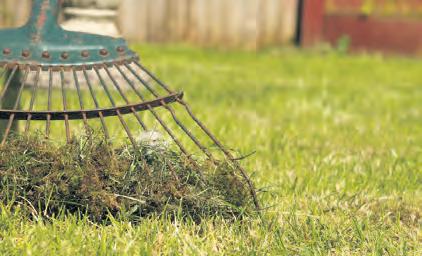
of bulb fibre (compost specifically designed for growing bulbs), then medium bulbs. Continue the process until all bulbs are planted in order of size, and top with violas that are currently in bloom.
• Camasias – September
• Daffodils – Sept-Oct
• Crocus – Sept to Oct
• Alliums – Sept – Nov
• Winter Iris – Sept-Nov
• Tulips – later in November
Keep wildlife in mind
Shrubs with berries will not only add bright reds and yellows to your garden over the winter but will also encourage birds to your garden as they will eat the fruit. The birds will then help you protect your plants by keeping caterpillars and aphids in check!
Feeding the shrubs with will help keep them lush and full.
Mulch is your friend
Continue to weed and clear leaves from any borders and add mulch (products like bark that help enrich soil) in a thick layer on top of your soil. This will help protect roots from winter cold and stop soil from being washed away - as well as keeping weeds at bay and adding nutrients to the soil.
Some favourite additions to mulch:
Consider colour over the colder months
Now is the time to dig up any old summer annuals (plants that flower for one season before dying) for compost and replace them with plants that will bloom in the autumn and winter such as violas, pansies, bellis daisies, wallflowers and cyclamens. These will add colour over the colder months and keep your garden looking bright.

Bulbs are your best friends
Bulbs are one of my favourite quick and easy wins to add colour to the garden (and a cheaper option than buying flowers in spring!) that can be planted in autumn. Plus, they then need very little maintenance until the spring!
Make a ‘bulb lasagne’ to create a successional display of gorgeous flowers throughout spring. Layer your bulbs in a container, with the biggest and latest flowering at the bottom. Follow with a layer
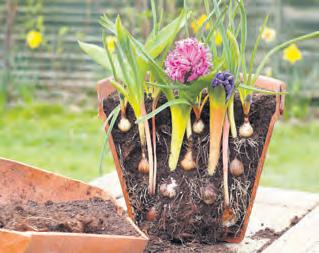
• Loose dog hair or human hair to help birds and wildlife in making their nests.
• Extra animal bedding (such as rabbit bedding), or wet shredded newspaper to help with insulation.
Add structure with shrubs
Plant evergreen shrubs in autumn to help brighten the garden when other plants go dormant. Fatsia japonica, Acuba japonica and Skimmia japonica are fantastic options that can add structure and light with their large, glossy green leaves.
Help Your Houseplants
Now the sunlight is not as hot, houseplants can be moved nearer a natural light source.
Make sure they’re kept away from any cold draughts, and not placed too close to heat sources like radiators or open fires.
The following plants are a fantastic way to brighten up your home during the cold, dark months:
• Moth orchid - this will still need the occasional feed and water
• Pink Quill -very little care is needed by pink quills, that will flower in the winter if exposed to enough sunlight
• Flaming Katy - this plant comes in an array of bright colours such as yellow and pink, and if bought in flower in autumn will still bloom if it is kept warm and bright. Feeding a Flaming Katy once a month will help its longevity.
SUBSCRIBE NOW
..and treat yourself to a gardening delight
P P
Ten issues throughout next year
Just £20 for a respected, knowledgeable and inspirational gardening magazine
Hassle free and delivered to your door every month
The perfect
The subscription costs just £20 and guarantees a 10 times a year magazine packed with information , gardening advice, local events.
You can select from one of our five editions of the magazine which is relevant to where you live.
Subscribing is simple.
Just fill in the form below and include your cheque for £20.
I would like to subscribe to Country Gardener for the next ten issues for £20:
This is a subscription just for me *
This is a gift (send next available issue) *
Please choose your region by ticking the box: Cotswolds * Devon * Dorset * Somerset * Hampshire *
Your details:
Title Forename Surname
Address Postcode
Tel No
Details of gift recipient:
Title Forename Surname

Address Postcode
Tel No
Complete this form and include a cheque for £20 made out to Alro Publishing Ltd and send to: Magazine Subscriptions, Country Gardener, Mount House, Halse, Taunton, Somerset TA4 3AD.
Remember to tell us which one of the five editions you would like to receive.
SUBSCRIPTIONS
October golden scythingPLUS: Sorbus, Become better gardener swallows of summer Garden the Cotswolds Cotswolds www.countrygardener.co.uk Issue 190 OCTOBER 2022 FREE
pear TIMING IS THE KEY FOR ENJOYING THEM Autumn fruit growing special: Secrets of October tree planting; Great fruit for small gardens; The best tasting apples ever 10.30am HOLIDAY GARDEN CENTRE Road, Nr. Banbury OX17 690479Autumn Gardening www.farnboroughgardencentre.co.uk centre quality giftware P www.countrygardener.co.uk 29
Can you become a better gardener?
Magazines
Editorial Publisher & Editor: Alan Lewis alan@countrygardener.co.uk
Tel: 01823 431767
The
October can be a time when we start to look back over the season. There’s plenty to harvest and it’s a time to judge how well our crops have performed and how well we’ve managed the garden. It’s a time to look at things we did right and things which went wrong and what lessons have been learnt.
A gardener’s knowledge is never complete and there’s always the opportunity to master a new skill or hone one you’ve tried before. Also take the opportunity to reimagine your garden and transform it into a more enjoyable place to be. So, all in all now’s the time to be a better gardener.
1 .Make more plants
Propagating and making new plants from scratch is almost certainly something we can all do more of. Plants are expensive so it’s a great way to get free plants. Keeping seeds, dividing clumpforming perennials and taking cuttings often all appear on things we want to do but often don’t get round to. Autumn is the time to divide herbaceous perennials so that’s where to start.
2. Planting
This is one of the first skills any gardener tries and is a crucial step. Doing it well makes the difference between a thriving or a sickly plant. Good soil preparation is essential, as is a strict routine of digging holes, aiding root systems and preparing the soil. Autumn is the best time to plant anything hardy.


3.Growing to eat
Can and should you be growing more of your own vegetables? Home grown tastes better and saves your purse. Even in the smallest of gardens there’s the opportunity to pack in edible plants. Most of us dabble a bit when it comes to vegetables but perhaps now is the time to ask yourself if you can do more?
4.Watering
Water is now a precious resource. We need it for our gardens so becoming a water wise gardener is going to be more important than ever if we are to have more drought affected summers like this one. So, water butts, irrigations systems, watering when it's really essential and automatics timers will all come into play as we make the most of creating a better garden with less water.

6. Understanding nature
5. Controlling weeds
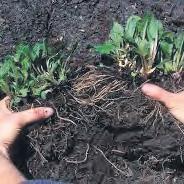
The oft quoted definition of a weed being a plant in the wrong place is still true. It has to be a principle of successful gardening to edit out the unwanted weeds. Weeds can overwhelm other plants, compete with them for water and nutrients and may host pests and diseases. Managing weeds needs a system, regular and painstaking . Leave it for a week in the growing season and there’s a lot of damage caused. Start now by preventing weeds releasing their seeds by pulling them up and or cutting off their seedheads.
Gardening shouldn’t all be about hustle and bustle, plant, water prune and so on . There needs to be a time to have patience stop and look and not expect too much too soon. The gardening season is a long and often testing one and understanding nature is a skill of the gardener who is learning to work with, not against, nature.
7. Coping with pests
A garden is a diverse eco system with a huge range of creatures, some good, and some harmful. Most are beneficial so where a garden is managed sympathetically without chemical sprays and plants that attract natural predators a balance of nature is reestablished. The trick is being vigilant and acting early so pests don’t build up.
8. Training and pruning
Our ability to prune properly is often underrated in any garden. It keeps plants productive and healthy, encouraging them to grow how and where you want. So think about why the plant needs pruning and only make cuts to reach that aim. Remember to make cuts just above a bud or leaf as this stimulates new shoots and avoids leaving a stump.
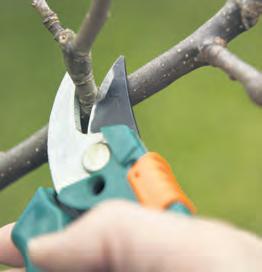
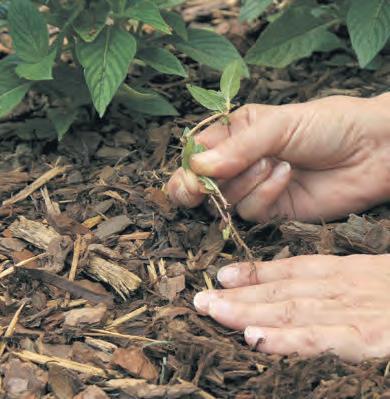
9. Looking after your soil
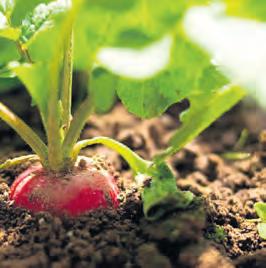
More time and money spent in getting your soil healthy is never ever wasted. All soil types can be improved with rotted organic manure. Mulching plants improves growth by suppressing weeds, adding nutrients, insulating roots from extremes in temperature and reducing water loss. Making your own garden compost is essential and there may be a need to improve composting skills. Act now by starting to collect autumn leaves and put into a chicken wire cage and allow to rot down into leafmould.
10. Weather proofing
Climate change is it appears happening faster than we’ve been told. This summer seemed to be a clear indication of how our gardens might have to adapt in the future. So, the skilled gardener will need to be sensitive to temperature and rainfall by looking regularly at your garden and choosing plants that will thrive on your gardens soil and site. Always research the needs to plants before buying them. If you put the right plant in the right spot, it will thrive.
Time Off Kate Lewis timeoff@countrygardener.co.uk
Advertising Sales
Ava Bench - Somerset & Hampshire ava@countrygardener.co.uk
Tel: 01278 786139
Cath Pettyfer - Devon cath.pettyfer@countrygardener.co.uk
Tel: 01837 82660
Corina Reay - Cotswolds & Dorset corina@countrygardener.co.uk
Tel: 01823 410098
Classifieds classified@countrygardener.co.uk
Design & Production Aidan Gill aidan@countrygardener.co.uk Gemma Stringer gemma@countrygardener.co.uk
Distribution & Stockists
Pat Eade distribution@countrygardener.co.uk
Tel: 01594 543790
Accounts and subscriptions
Heather Rose heather@countrygardener.co.uk
country stores and farm shops in each county.
rights reserved.
this
which
Country Gardener magazines are distributed FREE at Nurseries, garden centres, National Trust Properties, open gardens, garden machinery specialists,
All
No part of
publication may be reproduced, stored or made available in any form, without the written permission of the copyright holder and Publisher, application for
should be made to the Publisher. Unsolicited material: do not send or submit your only version of manuscripts and/or photographs/transparencies to us as these cannot be returned to you. While every care is taken to ensure that material submitted is priced accurately and completely, we cannot be responsible or liable for any loss or damage suffered. Views and/or opinions expressed in this publication do not necessarily represent those of Country Gardener or the Publisher. Printed by Mortons Print Ltd, Morton Way, Boston Road Industrial Estate, Horncastle, LN9 6JR.
A gardeners’ knowledge is never complete - whether you are a beginner or a seasoned pro there’s always more to learn and more core skills to improve on
Be who you’ve always been...
a family man doesn’t stop when you make the journey into care.
you can call
centred care

over 40 years.
one
www.countrygardener.co.uk 31
a family man Being
Bring your life with you to a place
home. Award winning, person
homes for
If you’re considering care for yourself or a loved
call 0333 060 7122 . Trusted to care. Highmarket House, Banbury Millers Grange, Witney Sandfields, Cheltenham Scarlet House, Stroud careuk.com/cotswolds
Autumn.... the very Best Time forPlanting Trees and Shrubs
The soil is still warm and moist so plant roots establish quickly - ready for new shoots and leaves to burst into growth next spring.

Ornamental Trees -

Flowering Cherries,
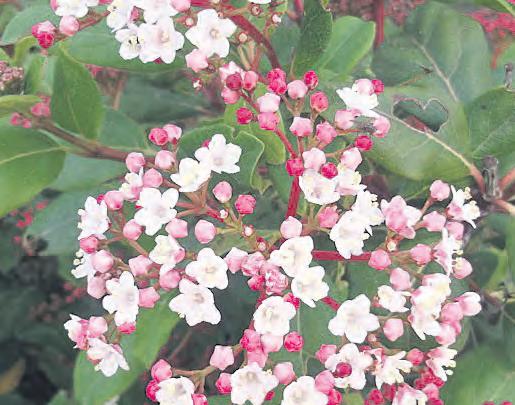
Fruit Trees and Fruit Bushes - Best planted before the end of the year! - Apples, Pears, Plums, Cherries, Damsons. Raspberries, Currants, Gooseberries etc
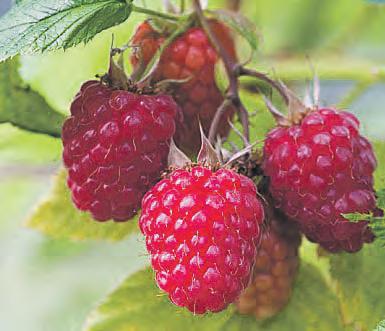
Malus, Betula & Sorbus.
huge
Shrubs for Autumn & Winter Colour - Hamamelis, Viburnums, Skimmia, Callicarpa, Cornus, Nandina, Clematis etc
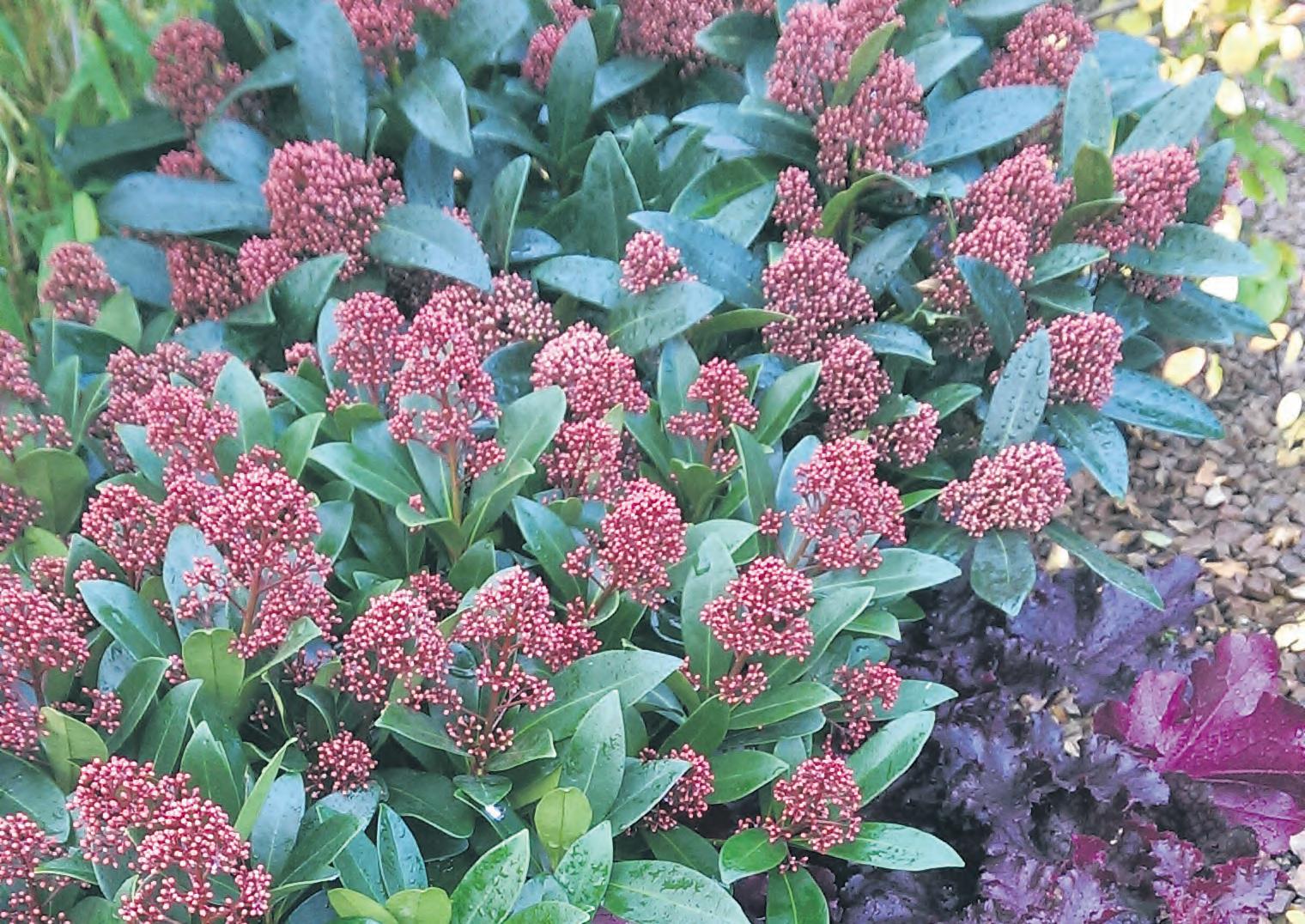
top quality locally grown Trees
like Liquidambar,
Spring Flowering Bulbs - great for the Garden or Patio Pots - Narcissus, Tulips, Alliums, Crocus, Hyacinths

Davidia,
etc
Heucheras - we have the biggest selection in the South West !!! Stunning foliage colours, Easy to Grow, Ideal for Pots!
RHS
Open 7 Days a week Newent Plant Centre @ The Nest, Little Verzons, Hereford Road, Ledbury HR8 2PZ. TEL: 01531 670121 EMAIL: enquiry@newentplantcentre.co.uk www.newentplantcentre.co.uk Follow us on Facebook and Twitter
we have a
range of
Fabulous
Plus unusual varieties
Liriodendron,
Halesia
Newent Plant Centre @ The Nest, Little Verzons, Ledbury Herefordshire’s Most Inspirational Plant Centre Trumpet Inn Verzons Hotel HEREFORD LEDBURYA438 Newent Plant Centre @ The Nest A417 LEOMINSTER A4172 DYMOCK & NEWENT Friendly advice always available from Mark and his team
Gold Medalists We sell and accept Find us @ The Nest just 3 miles west of Ledbury
